


This site is made possible by member support. ❤️
Big thanks to Arcustech for hosting the site and offering amazing tech support.
When you buy through links on kottke.org, I may earn an affiliate commission. Thanks for supporting the site!
kottke.org. home of fine hypertext products since 1998.
Entries for October 2020
What Do I Need to Do to Get You Into a Membership Today?
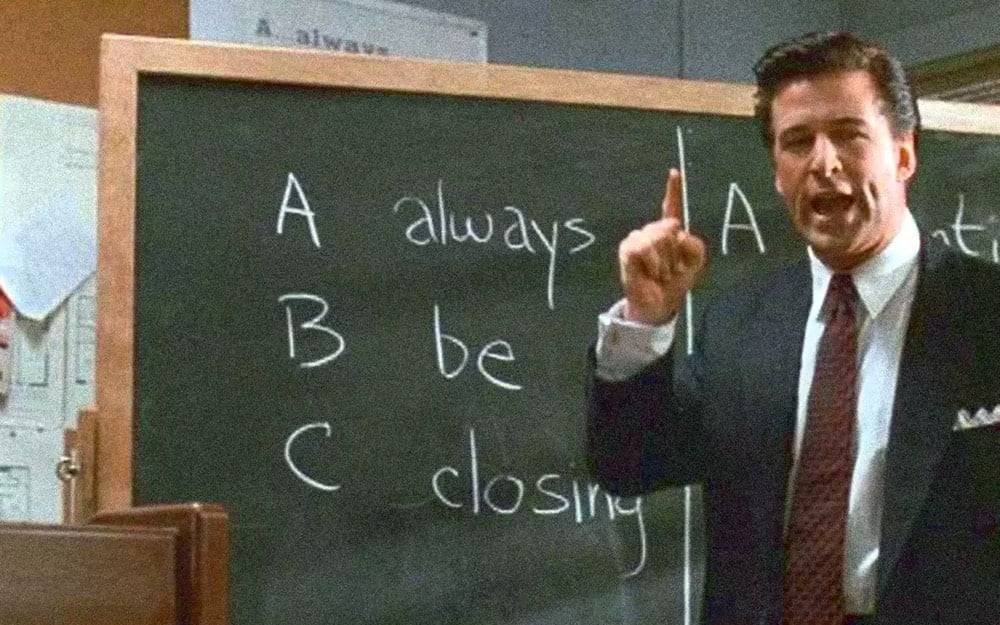
Hey look, I’m not going to give you the hard sell this year. (Ok, I never do — it’s just not in my nature.) Four years ago I introduced the kottke.org membership program so that folks reading the site could directly support my efforts here, and it’s been wonderfully successful. Or to put it another way, without that member support, this site would not exist.
Why wouldn’t it exist? The online advertising market for small sites like this sucks (especially for non-vertical sites) and I’ve nearly stopped linking to Amazon, losing the corresponding affiliate revenue that comprised 15-20% of my total annual revenue. As much as I like linking to Bookshop.org instead, the revenue from their affiliate program has only filled a tiny bit of that absence.1 Member support is far and away the thing that’s keeping me going here.
I know these are աɛɨʀɖ ȶɨʍɛֆ and that can make it tough to support things like non-essential websites. If you can’t swing it right now, please don’t! And don’t worry about it. If you’re currently a member worried about your finances and a refund of this year’s membership amount would help out, send me an email and let’s make that happen. But if you find value in this site and can manage it, I’d appreciate you supporting the site with a membership, especially if you’re someone who values the switch to Bookshop.org and that the advertising on the site is both minimal and relevant. And if you’re already a member and want to remain so (or even to bump up your membership level), maybe log in to check your status — it’s easy for a credit card to expire and you miss the email…
Ok, that was maybe a bit of a hard sell. But it’s over now. Thanks for hearing me out, I’ll follow up next week with a brochure about that Playa del Carmen timeshare, and you have yourself a lovely weekend. *big gold-toothed Joe Pesci from Home Alone smile*
Bookshop’s affiliate percentage is much more generous than Amazon’s is, but their prices are higher, popular books are often out of stock, shipping is slower than Amazon’s, and their site search is not great. I support their mission, but they have some work to do to make this a viable shopping experience for people who aren’t 100% into their goal of helping small bookstores.↩
What Do Foreign Media Correspondents Think of the US?
Media correspondents from all over the world spend months and years in the United States, reporting on our current events, politics, and culture. In this illuminating video from the New Yorker, several of them talk about what they think of our country. As outsiders, they’re able to see things that Americans don’t and can talk to people who may not otherwise feel comfortable talking to (what they perceive as) biased or corrupt American media. They’ve also observed an unprecedented level of division and are aware of the disconnect between America’s rhetoric about freedom and the sense that they’re reporting from a failed state.
A list of 53 reasons to vote this year. “46. Because many thousands of Americans have died needlessly from Covid-19.” (That should actually have been #1.)
An Archive of Pandemic and Anti-Racist Street Art

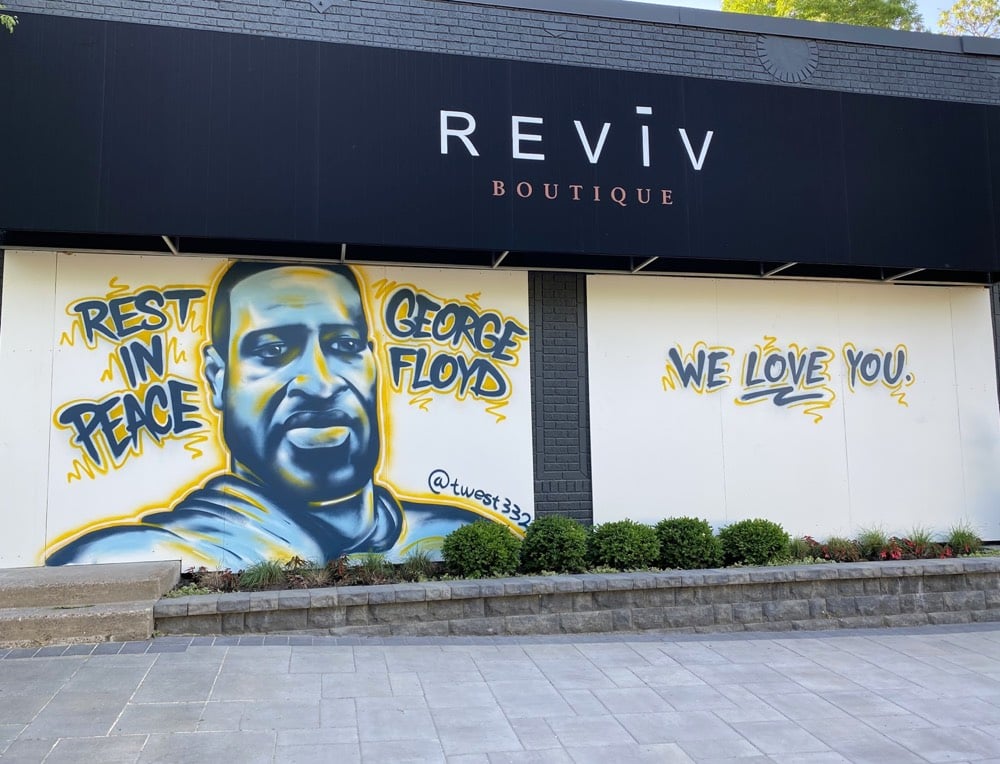
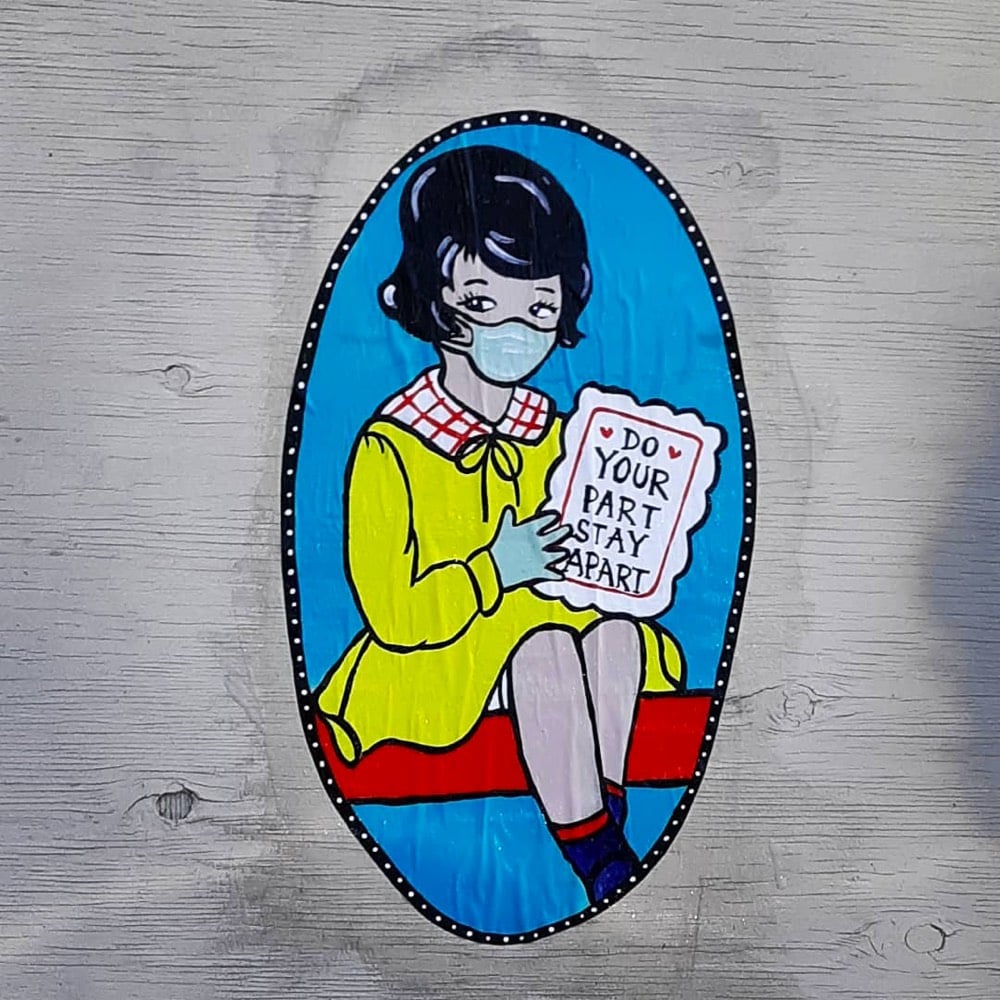
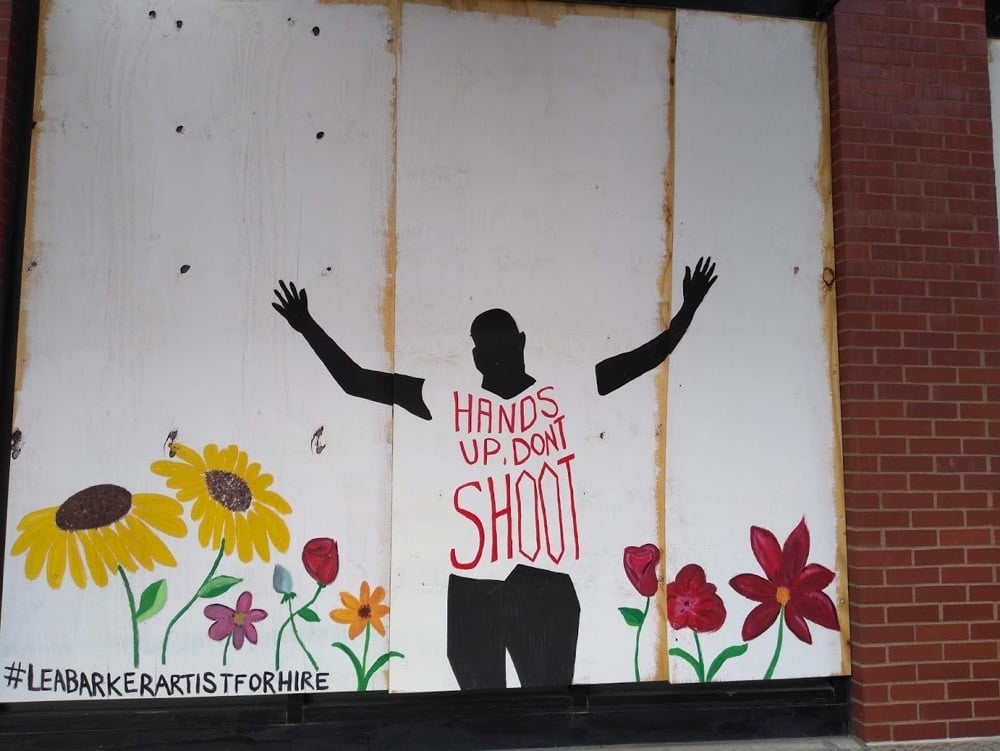
The Urban Art Mapping Research Project has been collecting photos of street art created over the past several months related to the Covid-19 pandemic and the anti-racist protests.
Artists and writers producing work in the streets — including tags, graffiti, murals, stickers, and other installations on walls, pavement, and signs — are in a unique position to respond quickly and effectively in a moment of crisis. Street art’s ephemeral nature serves to reveal very immediate and sometimes fleeting responses, often in a manner that can be raw and direct. At the same time, in the context of a crisis, street art also has the potential to transform urban space and foster a sustained political dialogue, reaching a wide audience, particularly when museums and galleries are shuttered.
(via open culture)
I don’t know who needs to hear this but… Colorado is not a rectangle. And not just because the Earth is round. Surveying errors mean that the seemingly 4-sided state actually has 697 sides.
Five Nice Things
After Siobhan O’Connor wrote about a game she plays with a friend called Five Nice Things — which she called “a less-corny name for a gratitude exercise” — my friend Michael Sippey shared his five nice things. And since I need a reminder about some of the good things in my life right now, I’ll share mine with you.
- Friends. Like many of you, I’ve had to tighten my circle of friends during the pandemic just out of the necessity of not enough time/energy. That’s been hard, but the few friends that have pulled closer…those connections have been essential in navigating all of this. I’m especially grateful for rebuilding a meaningful friendship and forming a co-parenting partnership with Meg. ♥
- Every year in the fall, I go apple picking with the kids and make apple pies. I’ve been tinkering with the recipe — different crusts, different fillings — and I think I’ve settled on something I’m happy with. Maybe I’ll make another one this weekend…
- There’s a ramen place in the tiny town I live in that’s better than it has any right to be. I order takeout from them almost every week and it’s such a treat every time.
- Since I won’t be traveling anywhere anytime soon, Instagram has been essential for keeping a passive connection to friends all over the world. Liking each other’s photos, the occasional DM, comments on Stories/posts — it’s the same kind of lightweight asynchronous interaction that’s connected folks online since Usenet & CompuServe. I wish we could figure out a way to do this outside the context of massive user-indifferent companies, but going without is not an option for me right now.
- I’ve picked up playing Rocket League on the Switch over the past few weeks. It’s footie with the lads but with cars and the lads are anonymous 10-year-olds from New Jersey who are way better than I am. Good fun.
Beloved Children’s Book Covers Reimagined In a Modernist Style
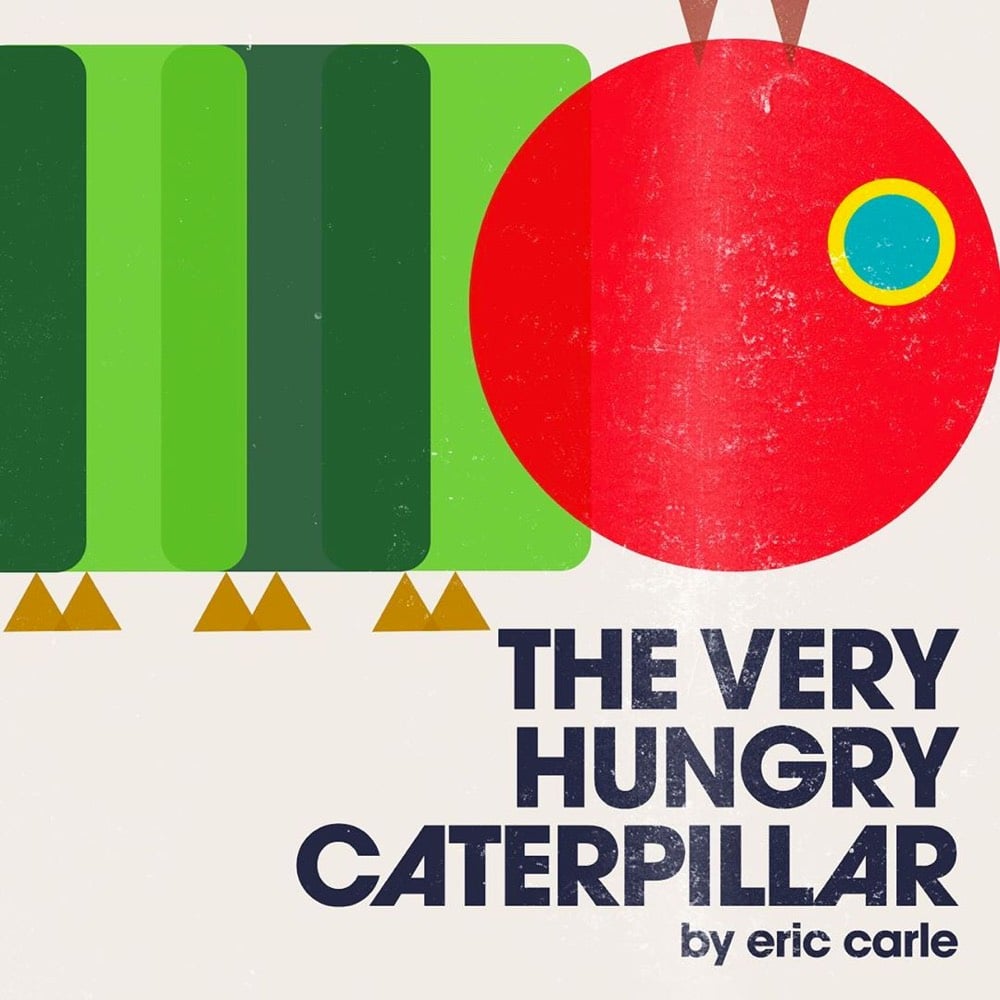
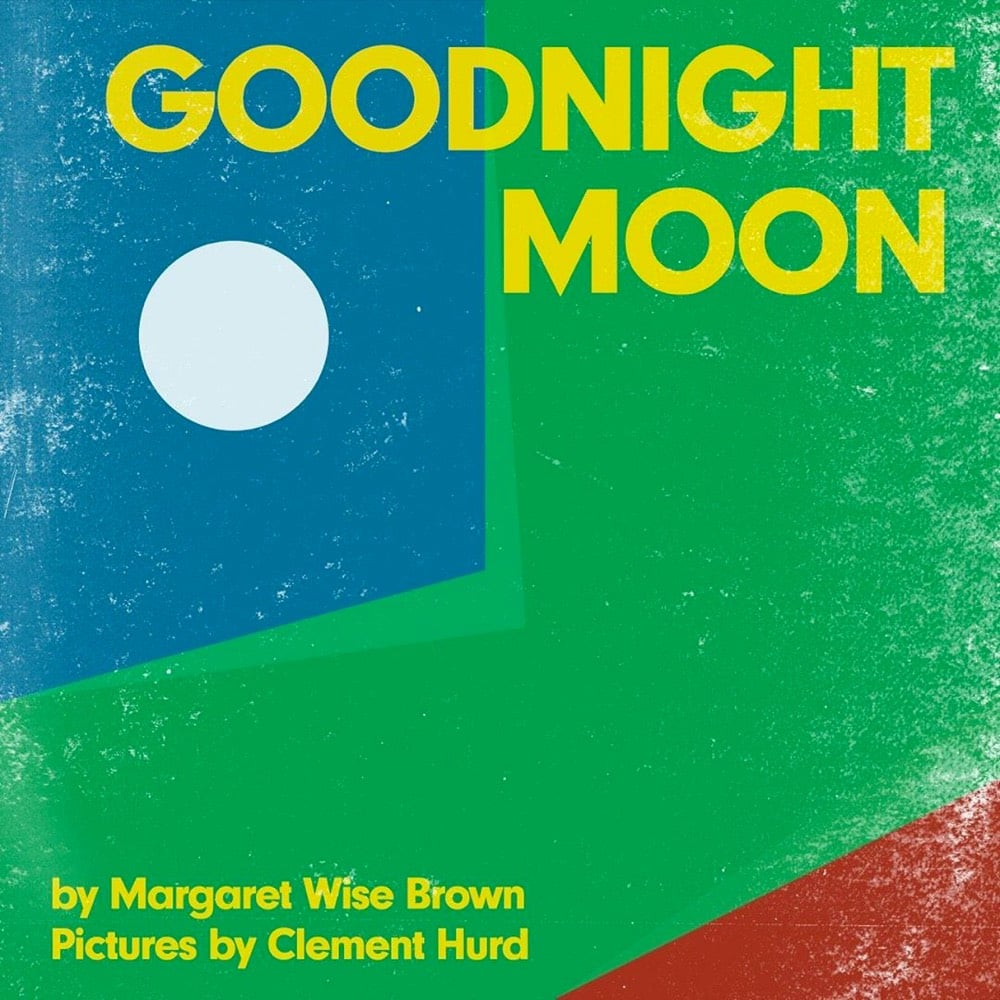
Over on his Instagram, Raj Haldar is making modernist versions of book covers for children’s books. So far there’s Goodnight Moon, The Snowy Day, The Very Hungry Caterpillar, Haldar’s own P Is For Pterodactyl, and a few others. Here’s what he says about Goodnight Moon:
Today, I’ve reduced ‘Goodnight Moon’ to nothing more than a few circles, rectangles, and triangles. What’s amazing, and a testament to how deeply this classic picture book is embedded in our collective consciousness is that even as a collection of the most simple forms, the cover is thoroughly recognizable.
(via print)
How the Instagram Influencer Aesthetic Is Being Used to Sell QAnon
Over the summer, members of the QAnon cult started to take over the “Save the Children” movement on Instagram & Facebook, eventually luring lifestyle influencers into spreading the cult’s message. From the NY Times:
But new research suggests that the biggest jolt to QAnon came from the so-called “Save the Children” movement. It started out as a fund-raising campaign for a legitimate anti-trafficking charity, but was then hijacked by QAnon believers, who used the movement to spread false and exaggerated claims about a global child-trafficking conspiracy led by top Democrats and Hollywood elites. This hijacking began in July, around the same time that Twitter and Facebook began cracking down on QAnon accounts.
What happened is QAnon folks started mass-faving posts about Save the Children and trafficking, so influencers began posting more content related to those topics, using bogus statistics and QAnon talking points. As the video from Vox above explains, child sex trafficking is a legitimate issue but QAnon’s claims about it — and the Instagram-aesthetic memes it has spawned — do not reflect reality. From Michael Hobbes at Huffington Post:
First of all, decades of social science research has found that the vast majority of children are abused by someone they know, usually their parents but sometimes other children or figures of authority they trust. “Stranger danger” kidnappings, on the other hand, are extremely rare — the latest estimate is 115 per year in the entire United States.
Second, the summer-long panic about missing children is almost entirely based on faulty statistics. Though it’s true that more than 400,000 children are reported missing each year, that is not even close to the number who disappear. The vast majority of these reports are misunderstandings or runaways. Roughly 10% are kidnapped by a parent as part of a custody dispute. Over 99% return home, most within a few days.
Vanity Fair’s cover story profile of Alexandria Ocasio-Cortez. Reading this, I really worry about how much weight we’re placing onto this one person, supporters and detractors alike.
Trailer for Season Four of The Crown
For the fourth season of Netflix’s drama on Queen Elizabeth and the British monarchy, The Crown moves into the 1980s. The first full trailer features two women who largely defined Britain in that decade: Margaret Thatcher (played by Gillian Anderson) and Lady Diana Spencer, later Princess Diana (played by Emma Corrin). As a fan of the first three seasons of the show and You’re Wrong About’s multi-part series on Princess Diana, I am very much looking forward to this.
The LIGO experiment has been incredibly successful, detecting 50 gravitational wave events in the past 5 years. “As surreal as it seems, the detection of gravitational waves has now become commonplace…”
Raised on 3 TV channels & the local newspaper, baby boomers are ill-equipped to navigate the digital media landscape and are being radicalized by Fox News, talk radio, and social media. “It feels like he’s been indoctrinated into a cult.”
The World’s Best Tree Felling Tutorial
Oh, I already know what you’re thinking. Who cares about how to cut a tree down? Who cares about 8 different ways to cut a tree down? Who cares about watching 45 minutes of 8 different ways to cut a tree down? I hear you. But this tree felling tutorial is actually really informative & entertaining and watching people who are good at their work, are good at explaining their work, and genuinely have a passion for what they do is always worthwhile. The top comments on the video are almost uniformly positive; here’s a representative remark:
I live off-grid in the forest (same mtn range as these guys) and for 30+ years I have been felling trees for fire-prevention, firewood, and home-milled lumber. I have fortunately never had an accident, but after watching this video I realized that was only dumb luck. After carefully studying this video (3 times through), as well as others on this channel, this year I have placed every tree exactly where I wanted (even the leaders) and I’ve done this in a much safer manner than before.
Did you know, for example, the extent to which tree fellers can accurately place a falling tree? I did not and their precision is impressive — I actually cheered when the tree fell during the sizwill cut demo.
Karen O and Willie Nelson Cover Under Pressure
Under Pressure, the classic tune from David Bowie and Queen, seems like one of those songs you don’t want to mess with — we’re looking at you here, Vanilla Ice. But if someone is going to cover it, it might as well be Karen O from the Yeah Yeah Yeahs and Willie Nelson.
(via open culture)
On the basis of his resume, no one would hire Donald Trump to do any sort of job. So maybe don’t vote for him either?
A 30-minute briefing with Anthony Fauci on current state of the Covid-19 pandemic conducted by JAMA editor in chief Howard Bauchner. Topics: national mask mandate, Thxgvng safety, treatment drugs, vaccines, etc.
Production hasn’t even started on season 2, but Ted Lasso has already been renewed for a third season. I was totally charmed by this show and its titular character.
Visualizing How Covid-19 Spreads Indoors

From El Pais, this is an excellent visualization of how Covid-19 spreads indoors via aerosols and what can be done to limit that spread. They go through simulations of three different indoor scenarios that are based on actual events — in a home with friends, in a bar at 50% capacity, and in a classroom — and see what happens when differing levels of precautions are applied: masks, ventilation, and limiting exposure time.
Six people get together in a private home, one of whom is infected. Some 31% of coronavirus outbreaks recorded in Spain are caused by this kind of gathering, mainly between family and friends.
Irrespective of whether safe distances are maintained, if the six people spend four hours together talking loudly, without wearing a face mask in a room with no ventilation, five will become infected, according to the scientific model explained in the methodology.
If face masks are worn, four people are at risk of infection. Masks alone will not prevent infection if the exposure is prolonged.
The risk of infection drops to below one when the group uses face masks, shortens the length of the gathering by half and ventilates the space used.
In all three scenarios, note that distancing is largely irrelevant when people gather indoors for longer periods in poorly ventilated areas. From the school example:
In real outbreaks, it has been noted that any of the students could become infected irrespective of their proximity to the teacher as the aerosols are distributed randomly around the unventilated room.
The only thing that’s disappointing about this piece is that it does not stress enough that finding alternatives to indoor activities with lots of people is the much safer course of action than just cracking a window or masking up. Safety step #1 is still being smart about non-essential activities — masks and ventilation are not magically going to protect you during risky activities. Educating our children is important and difficult (though not impossible) to do outside in many places, so yeah, let’s mask up and ventilate those classrooms. But your indoor birthday party with 10 friends or Thanksgiving dinner with the cousins and grandparents? Or dining out in a room full of strangers at a restaurant? Even with masks and ventilation, it’s not a great idea. Scale it down, move it to Zoom/FT, hold it outdoors (distanced, masked), or just skip it.
Can lab-grown brains become conscious? And if they can, should people be allowed to grow and destroy them?
Here’s What 10 Million Stars Look Like

Using the Dark Energy Camera at the Cerro Tololo observatory in Chile, astronomers took an image of the stars clustered around the center of our Milky Way galaxy that shows about 10 million stars. Check out the zoomable version for the full experience.
Looking at an image like this is always a bit of a brain-bender because a) 10 million is a huge number and b) the stars are so tightly packed into that image and yet c) that image shows just one tiny bit of our galactic center, d) our entire galaxy contains so many more stars than this (100-400 billion), and e) the Universe perhaps contains as many as 2 trillion galaxies. And if I’m remembering my college math correctly, 400 billion × 2 trillion = a metric crapload of stars. (via bad astronomy)
The Game of the Year: the 3D Virtual Walkthrough of 8800 Blue Lick Road
This week’s fun internet plaything has been the 3D virtual house tour of this three-bedroom house at 8800 Blue Lick Rd. in Louisville, KY. If you take the tour, you’ll quickly see why: from the standpoint of physics, the house doesn’t seem to make any sense. You think you’re in the basement and then head up some stairs to find yourself…still in the basement? It’s all very Inception crossed with the Winchester Mystery House with a side of How Buildings Learn.
So of course people turned it into a game: find the oddly located bathtub. They even started speedrunning it.
Resident internet meme sleuth Andy Baio called the owner of the house and got the scoop on the puzzling residence.
A larger question remained: what’s the deal with this place? Whoever owned it, they were too organized to be hoarders. The home appeared to double as the office and warehouse for an internet reseller business, but who sells a house crammed floor-to-ceiling with retail goods?
Internet sleuths unearthed several news articles from 2014, outlining how police discovered thousands of stolen items being sold online during a raid at the address, the result of a four-year investigation resulting in criminal charges for four family members living and working at the house.
But it didn’t add up. If they were convicted for organized crime, why was there still so much inventory in the house, with products released as recently as last year? Why is it still packed full while they’re trying to sell it? And what’s with the bathtub!?
I had questions, so I picked up the phone.
He also explains why the bathtub is no longer viewable in the 3D walkthrough.
Bummer: Alt-weekly City Pages is closing after 41 years due to the Covid-19 pandemic. Small local businesses of all kinds are just going to disappear.
America Is About to Choose How Bad the Pandemic Will Get. “If Donald Trump is reelected, he will continue to downplay the threat of the coronavirus, and more Americans will fall ill.” And die.
The Earthshot Prize
Earlier this month, Prince William (British royal) & David Attenborough (British royalty) announced The Earthshot Prize. Inspired by the moonshot effort of the 1960s, the initiative will award five £1 million (~$1.3 million) prizes each year over the next 10 years for projects that provide global solutions to pressing environmental problems in five different categories: fixing the climate, cleaning the air, protecting & restoring nature, reviving the oceans, and building a waste-free world.
The Earthshot Prize is centred around five ‘Earthshots’ — simple but ambitious goals for our planet which if achieved by 2030 will improve life for us all, for generations to come. Each Earthshot is underpinned by scientifically agreed targets including the UN Sustainable Development Goals and other internationally recognised measures to help repair our planet.
Together, they form a unique set of challenges rooted in science, which aim to generate new ways of thinking, as well as new technologies, systems, policies and solutions. By bringing these five critical issues together, The Earthshot Prize recognises the interconnectivity between environmental challenges and the urgent need to tackle them together.
(via moss & fog)
Quiz: Can You Tell a ‘Trump’ Fridge From a ‘Biden’ Fridge? “The current scores suggest that as a whole, we can’t distinguish people’s politics from glances into their fridges much more reliably than if we just flipped a coin.”
Why You Shouldn’t Worry About Studies Showing Waning Coronavirus Antibodies. “It’s normal for levels of antibodies to drop after clearing an infection, and that they represent just one arm of the immune response against a virus.”
Interviews with Titanic Survivors
In 1979 the BBC aired an interview with Frank Prentice, who was an assistant purser on the Titanic who survived the sinking of the ship in 1912. I’m not sure what to expect when I started listening, but I was completely captivated by Prentice’s tale.
#OnthisDay 1979: Frank Prentice, an assistant purser on the Titanic, described how he survived the sinking of the ship. For more archive on the Titanic, you can visit - https://t.co/fYwWoNhuBT pic.twitter.com/9Qi8zw5g0L
— BBC Archive (@BBCArchive) October 27, 2020
More information on the Mrs. Clark from his story is available here.
Mrs Clark left Titanic with Mrs Astor in lifeboat 4. She recalled Mrs Astor insisting that the lifeboat be turned around to rescue more people; the lifeboat eventually pulled around eight crewmen from the water. When the ship eventually founded Mrs Clark recalled the “heartrending moans and cries” of those struggling in the water.
There are many other interviews with Titanic survivors on YouTube, including this 40-minute feature of seven survivors telling their stories and this 1970 British Pathé clip:
(via @daniel_beattie)
No, Skiing Isn’t a Welcome Place for People of Color. “Skiing has long served as an escape for white people from multicultural politics and accusations of privilege, and that is precisely why we can’t leave race out of it.”
The Abolition Movement
Writing for Vanity Fair, Josie Duffy Rice lays out the case for the abolition of policing.
Despite much reporting of a spike in murder this year, the long-term trend still shows the murder rate hovering roughly in the same place it was in the 1960s, half of what it was in 1980. And while procedurals may paint a picture of cops chasing serial killers weekly, the actual face of police is more mundane. In June, the New York Times culled available data and estimated that police spend roughly 4 percent of their time addressing “violent crime.” Most of their time is spent dealing with noncriminal matters. And yet no matter the call — the loud party next door, the permit for a parade, the expired car tags, the escort for a funeral procession, the elderly welfare check, the frolickers barbecuing in the park, the schoolyard fight, the opioid overdose, the homeless person outside in the cold, the stray dog — the state’s answer is to respond with armed agents blessed with the near unimpeachable right to kill.
“Liberty Doesn’t Mean Freedom to Infect Other People”
Paul Krugman writes about the harmful effects of “libertarianism gone bad, a misunderstanding of what freedom is all about” that have been made plain by the Covid-19 pandemic.
But you also see a lot of libertarian rhetoric — a lot of talk about “freedom” and “personal responsibility.” Even politicians willing to say that people should cover their faces and avoid indoor gatherings refuse to use their power to impose rules to that effect, insisting that it should be a matter of individual choice.
Which is nonsense.
Many things should be matters of individual choice. The government has no business dictating your cultural tastes, your faith or what you decide to do with other consenting adults.
But refusing to wear a face covering during a pandemic, or insisting on mingling indoors with large groups, isn’t like following the church of your choice. It’s more like dumping raw sewage into a reservoir that supplies other people’s drinking water.
Arctic ice is too thin to properly test out a new Russian icebreaker. On the plus side, it might not be needed if the climate keeps going like this?
A 2.5 Gigapixel Image of the Orion Constellation
![]()
Amateur astronomer Matt Harbison has been working for the past five years on capturing a detailed image of the Orion constellation. He recently completed the project and the result is this 2.5 gigapixel photo mosaic composed of 12,816 individual photos. From PetaPixel, which has a good writeup of the project, a taste of the challenges involved with constructing this image:
Even after all the images were shot and each panel completed, the finished image did not come together smoothly. “I began in 2015 on a Mac Pro with 2 Xeon Processors and 64GB of RAM. This machine was easily one of the fastest computers of the day, and it carried me all the way up to panel 47 where I believe I hit the RAM limit of the computer.”
It would take five years from that point for technology to catch up to Harbison’s needs as he wouldn’t have a computer powerful enough to complete the task until August of 2020. “The new computer is an AMD Threadripper with 24 cores and 256GB of memory,” Harbison said. “It took a total of 23 hours to provide an astrometric solution for all 200 panels and then an additional 19 hours to merge into the gradient merge mosaic tool.”
What an amazing thing to be able to make from your backyard.
Map Portraits by Ed Fairburn
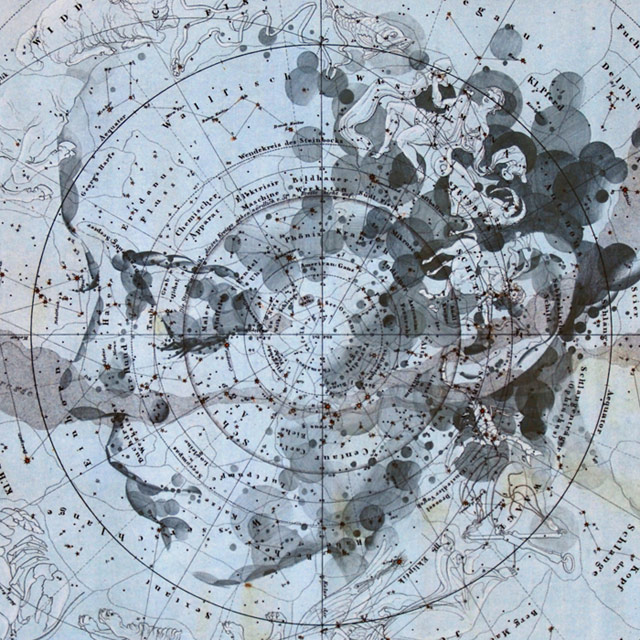
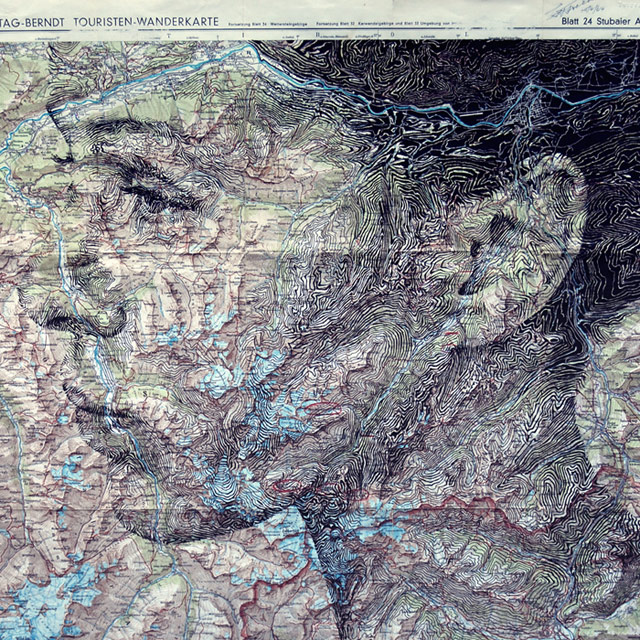
Artist Ed Fairburn draws portraits of people and objects on top of maps and, well, it is just my exact cup of tea. His newest stuff is available on Instagram. I’ve featured his work twice before and it won’t be the last. (via colossal)
This article about the role of close friendships in a society that privileges romantic relationships is worth a read. “When we channel all our intimate needs into one person, we actually stand to make the relationship more vulnerable.”
David Fincher says there probably won’t be a 3rd season of the excellent Mindhunter series. The show is too expensive and viewership is not high enough to support it.
Obama on the Struggle to Reform Healthcare in America
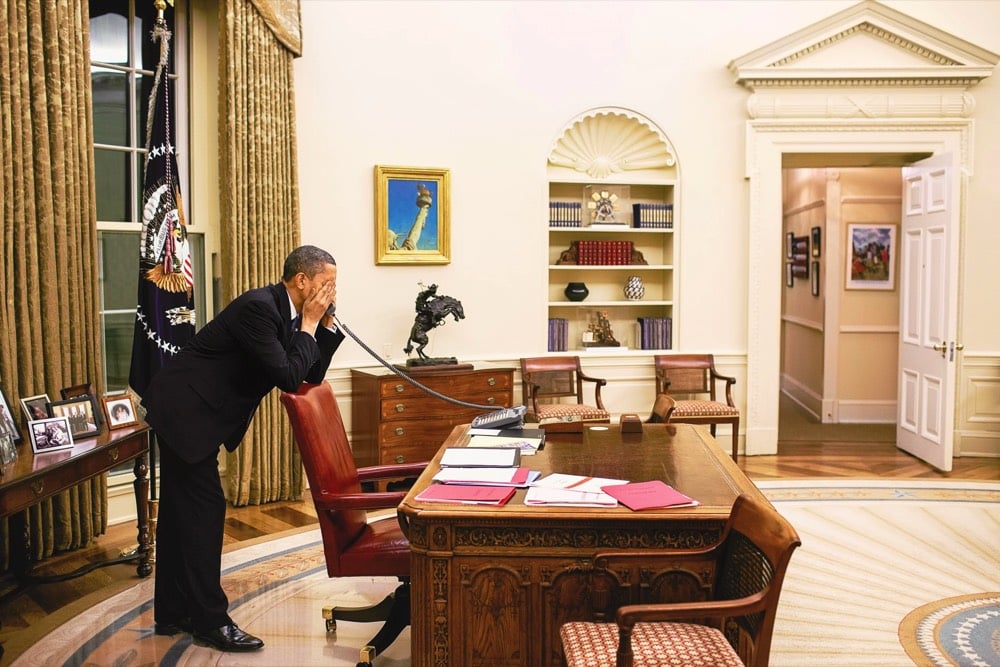
Barack Obama’s forthcoming memoir, A Promised Land, is coming out next month. The New Yorker is running an excerpt of the book, an account of his administration’s struggle to get the Affordable Care Act through Congress.
As time went on, though, it became hard to ignore some of the more troubling impulses driving the movement. As had been true at Palin rallies, reporters at Tea Party events caught attendees comparing me to animals or Hitler. Signs turned up showing me dressed like an African witch doctor with a bone through my nose. Conspiracy theories abounded: that my health-care bill would set up “death panels” to evaluate whether people deserved treatment, clearing the way for “government-encouraged euthanasia,” or that it would benefit illegal immigrants, in the service of my larger goal of flooding the country with welfare-dependent, reliably Democratic voters. The Tea Party also resurrected an old rumor from the campaign: that I was not only Muslim but had actually been born in Kenya, and was therefore constitutionally barred from serving as President. By September, the question of how much nativism and racism explained the Tea Party’s rise had become a major topic of debate on the cable shows-especially after the former President and lifelong Southerner Jimmy Carter offered up the opinion that the extreme vitriol directed toward me was at least in part spawned by racist views.
At the White House, we made a point of not commenting on any of this — and not just because Axe had reams of data telling us that white voters, including many who supported me, reacted poorly to lectures about race. As a matter of principle, I didn’t believe a President should ever publicly whine about criticism from voters — it’s what you signed up for in taking the job — and I was quick to remind both reporters and friends that my white predecessors had all endured their share of vicious personal attacks and obstructionism.
More practically, I saw no way to sort out people’s motives, especially given that racial attitudes were woven into every aspect of our nation’s history. Did that Tea Party member support “states’ rights” because he genuinely thought it was the best way to promote liberty, or because he continued to resent how federal intervention had led to desegregation and rising Black political power in the South? Did that conservative activist oppose any expansion of the social-welfare state because she believed it sapped individual initiative or because she was convinced that it would benefit only brown people who had just crossed the border? Whatever my instincts might tell me, whatever truths the history books might suggest, I knew I wasn’t going to win over any voters by labelling my opponents racist.
The harbingers of Trumpism throughout this piece are difficult to ignore.
Back to the Future: Reimagined
Back to the Future is 35 years old this year and to celebrate, Universal has cut together eight fan-made animations of action from the film into an abridged version of the beloved movie.
See also a deepfake version of BTTF with Tom Holland as Marty and Robert Downey Jr. as Doc.
Another thing that people are doing during the pandemic is repainting their home interiors. And a quarantine palette has emerged. “What we want on our walls now are blues and greens; organic neutrals…”
Is the McDonald’s Ice Cream Machine Broken?
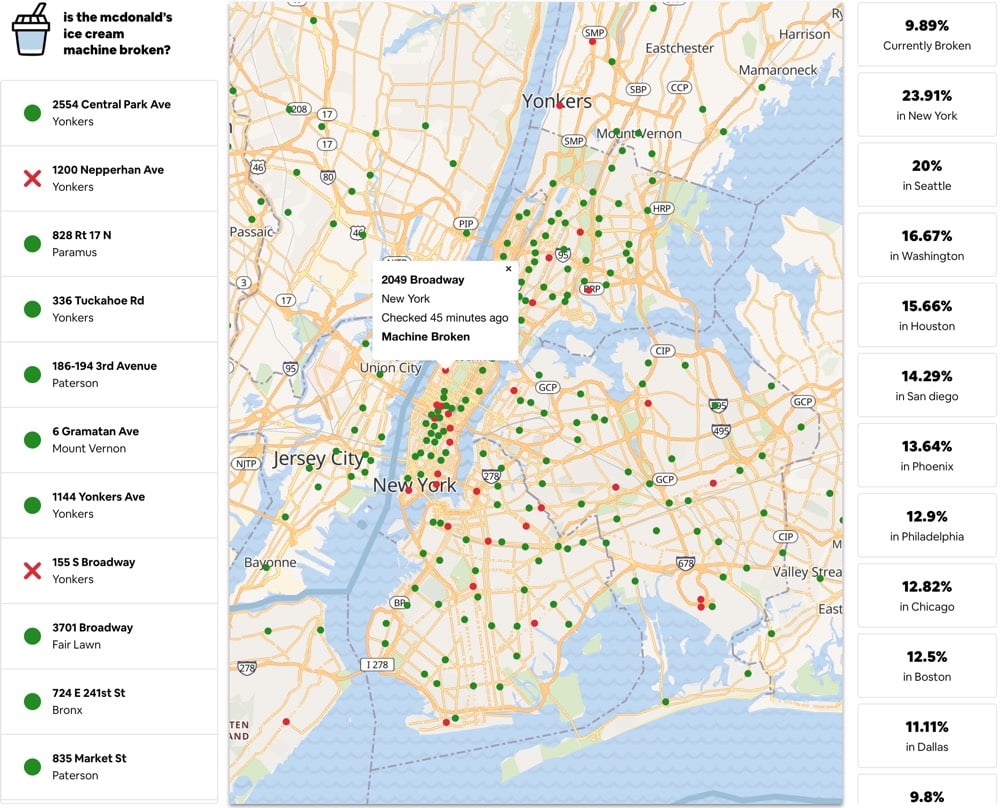
Software developer Rashiq Zahid figured out McDonald’s ordering API and built a program that attempts to order ice cream from every single McDonald’s in the US to check if their ice cream machine is working. If your McFlurry or McSundae cannot be added to the shopping cart, the program assumes the ice cream machine is broken. The program runs several times a day and the results are displayed on a map. From The Verge:
Initially, he created an API that attempted to add a McSundae from every McDonald’s location to its cart once every minute. The app figured out what he was up to and blocked him — “It was like, you can’t do this, you look like a bot,” he recalled.
After a night of trial and error, Zahid figured out the magic time frame. Now, his bot attempts to add a McSundae every 30 minutes. If the bot successfully adds the item, it lets McBroken know that the location’s machine is working. If it can’t, the location gets a red dot.
From the current map, it looks like almost 10% of McDonald’s ice cream machines in the US are not working. In NYC, nearly a quarter of McDonald’s restaurants don’t have a working ice cream machine. I’m wondering though: is the assumption that the machine is broken a good one? What if ice cream ingredients are out of stock or some franchises don’t offer ice cream products at all hours? When The Verge wrote their story last night, they reported only 7.5% of national machines and 15.2% of NYC machines were broken. Did 10% of McDonald’s ice cream machines in NYC break in the last 12 hours? Or are they just not selling McSundaes at 10am?
Update: A company started selling a device that helped franchise owners keep the notoriously finicky ice cream machines running — but then McDonald’s all but shut them down.
Update: In a 30-minute video, Johnny Harris investigated why the McDonald’s ice cream machines are broken so often.
At the heart of this ice cream problem is that McDonald’s customers are not actually the people who buy their food but the franchisees that run the restaurants. That and McDonald’s is actually a real estate business, not a food service business.
Fantastic 3-D Animation of How Medieval Bridges Were Built
The animation above shows how bridges were built in medieval times, well before the advent of backhoes, cranes, and bulldozers powered by steam and gasoline. I could explain what you’re about to see, but you should just watch the video.
The bridge constructed in the video is the real-life Charles Bridge in Prague, which was built over several decades in the 14th and 15th centuries. From Amusing Planet:
Construction of the Charles Bridge started in 1357, under the auspices of King Charles IV, but it was not completed until the beginning of the 15th century. The bridge has 16 arches and 15 pillars, each shielded by ice guards. It’s 512 meters long and nearly 10 meters wide. The balustrade is decorated with 30 statues and statuaries depicting various saints and patron saints, although these were erected much later, between 1683 and 1714. To preserve these statues, they were replaced with replicas during the 1960s. The originals are at Prague’s National Museum.
Until the middle of the 19th century, the Charles Bridge was the only crossing on river Vltava, which made the bridge an important connection between Prague Castle and the city’s Old Town and adjacent areas.
When I was younger, I remember watching (and loving) a PBS series on the building techniques used to construct the pyramids in Egypt, Stonehenge, the Colosseum, and Incan buildings. That the internet is now overflowing with engaging history videos like this bridge video is truly wonderful.
Merriam-Webster’s “Time Traveler” Tracks the First Known Use of Words by Year
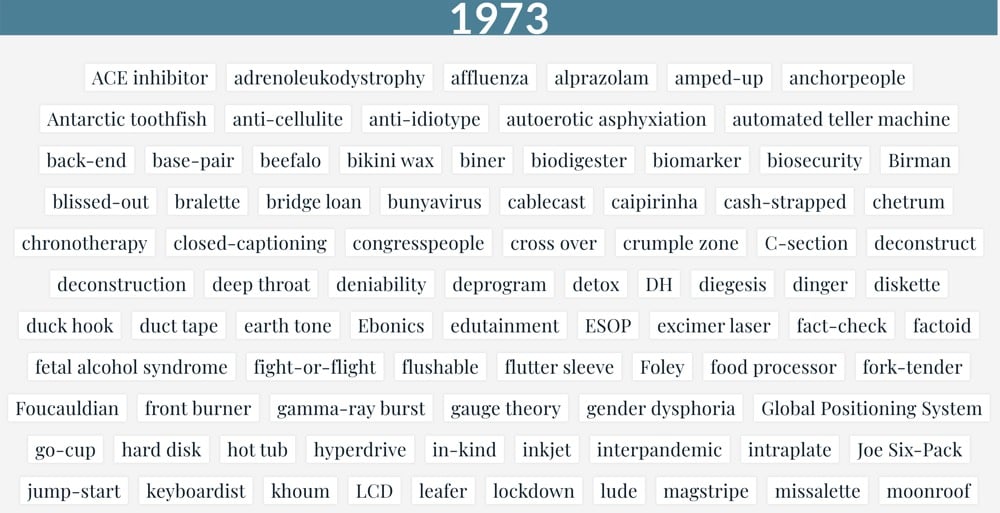
The English language, for better or worse, is constantly shifting and changing, with dozens of new and useful words being added to our collective vocabulary each year. With Merriam-Webster’s Time Traveler tool, you can browse what new words were first used in years dating all the way back to 1500 (and even earlier). The obvious thing is to look up your birth year, so I did that and then poked around for some other interesting years.
1973 (my birth year): automated teller machine, bikini wax, closed-captioning, gender dysphoria, hot tub, Joe Six-Pack, LCD, reverse engineer, soccer mom, televangelist.
2007 (the year my son was born): Bechdel Test, hashtag, retweet, crowdfunding, DM.
1969: ageism, crystal meth, gangbanger, in vitro fertilization, life coach, point guard, sexual harassment, sport utility vehicle.
1945: A-bomb, cold war, d’oh, game theory, graffiti, name-dropping, passive-aggressive.
1929: antiviral, blue-collar, burp, eyeliner, Marxism-Leninism, penicillin, preteen, QWERTY, Sasquatch, spacecraft.
1865: anti-Muslim, baseball cap, gasoline, pessimistic, potato chip, showerhead.
1776: anthrax, division of labor, killjoy, natural resource, slaveholder, sour cream.
1619: bungled, diagram, libelous, retributive, sarcasm.
1561: aristocracy, curator, index, orgy, random, tarantula, well-being.
1500: cadaver, illness, minion, polite.
This is extremely inexpensive time travel. Almost every year is a gold mine (1605!) of terms that are seemingly out of time, either too early or too late. Careful, you might lose several hours to this. (thx, megan)
Tom Vanderbilt on the benefits of playing video games with your kids. (My son read this in my copy of Wired, interrupting himself several times telling me to read it. “He makes lots of good points!”)
The Japanese Sustainable Forestry Technique Called Daisugi (Platform Cedar)

Daisugi is a sustainable forestry technique that originated in Kyoto in the 14th or 15th century. The tops of Kitayama cedar trees are carefully pruned so that a stand of very straight branches grow straight up from a main platform. From Spoon & Tamago:
The technique was developed in Kyoto as a means of solving a seedling shortage and was used to create a sustainable harvest of timber from a single tree. Done right, the technique can prevent deforestation and result in perfectly round and straight timber known as taruki, which are used in the roofs of Japanese teahouses.
The technique is not really used in forestry anymore, but daisugi are popular as garden trees and bonsai. There are lots of terrible videos about daisugi on YouTube, so I’d recommend watching this one from NHK about how Kitayama cedars are pruned & harvested, what the wood is used for, and a short segment on daisugi near the end.
I don’t know if a monopoly is to blame, but Google’s search results for many things have been *awful* for years. SEO garbage has swamped the genuinely useful and thoughtful results.
Watch a NASA Spacecraft Touch Down On an Asteroid to Collect a Sample
On Tuesday, NASA’s OSIRIS-REx spacecraft touched down on an asteroid called Bennu for about six seconds in order to collect a mineral sample to bring back to Earth.
The Origins Spectral Interpretation Resource Identification Security - Regolith Explorer spacecraft will travel to a near-Earth asteroid, called Bennu (formerly 1999 RQ36), and bring at least a 2.1-ounce sample back to Earth for study. The mission will help scientists investigate how planets formed and how life began, as well as improve our understanding of asteroids that could impact Earth.
The video above is a time lapse sequence of the touch down, sampling, and subsequent take off.
These images were captured over approximately a five-minute period. The imaging sequence begins at about 82 feet (25 meters) above the surface, and runs through the back-away maneuver, with the last image in the sequence taken at approximately 43 feet (13 meters) in altitude — about 35 seconds after backing away. The sequence was created using 82 SamCam images, with 1.25 seconds between frames.
America’s Nuclear Sponge
The “nuclear sponge” is a colorfully named Cold War-era concept whereby stationing a massive collection of ICBMs in sparsely populated areas of the United States would serve to “soak up” a nuclear attack from the Soviet Union, drawing fire away from populated targets like NYC, Chicago, and Seattle.
Before the development of nuclear-armed submarines that can hide their locations at sea, ICBMs were the crux of American nuclear strategy. Today, however, their only purpose is to draw fire away from other targets (like New York and San Francisco) in the (suicidal and thus highly unlikely) event of a first strike by Russia. The Air Force does not plan to launch the missiles in a war, but to have them draw a nuclear attack to the Upper Midwest.
We’re not making this up — that’s what former Defense Secretary Jim Mattis told Congress.
Here’s what the nuclear sponge looks like, courtesy of the National Park Service (areas in black have been decommissioned):
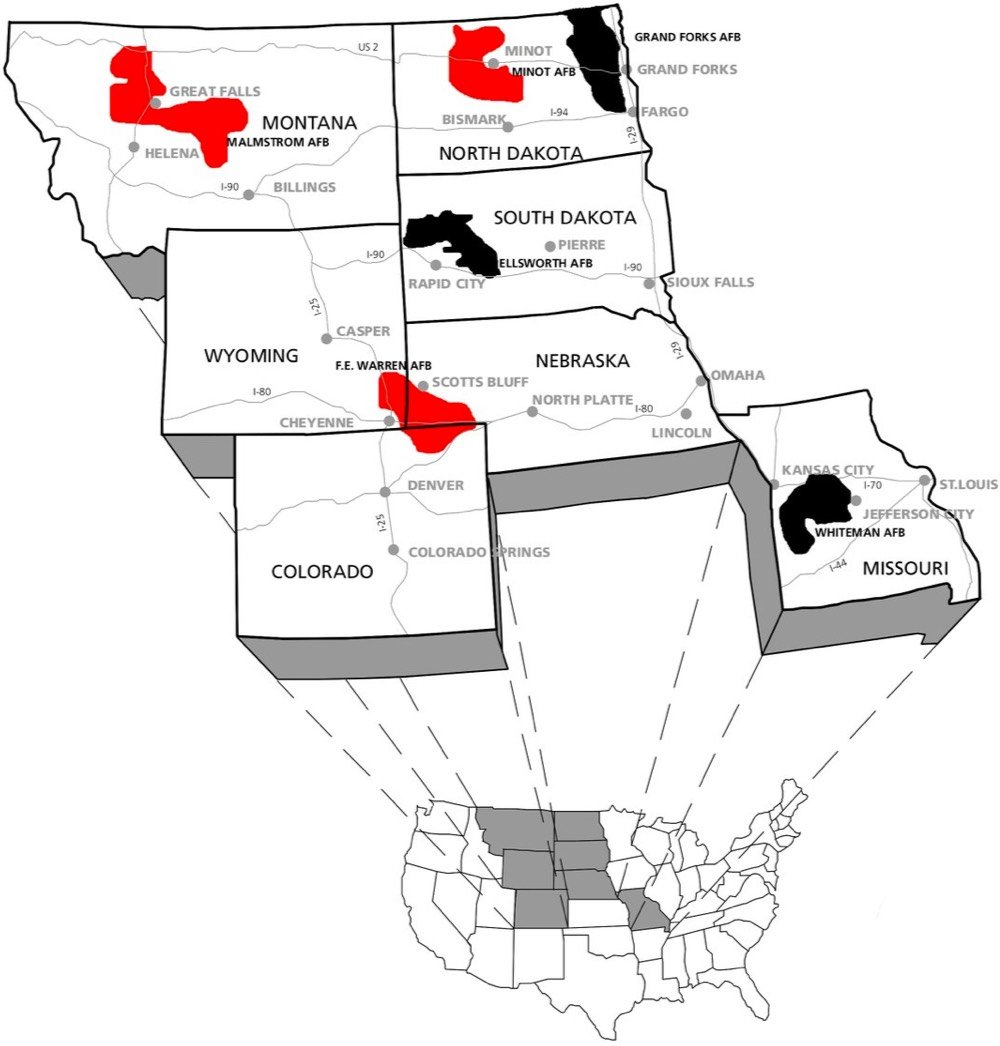
The amazing/crazy thing is that the sponge is not only still an active strategy, but the Pentagon is planning on replacing the sponge arsenal with new missiles at a cost of $95.8 billion.
“Reverse Toonification” of Pixar Characters
Using an AI-based framework called Pixel2Style2Pixel and searching for faces in a dataset harvested from Flickr, Nathan Shipley made some more photorealistic faces for Pixar characters.
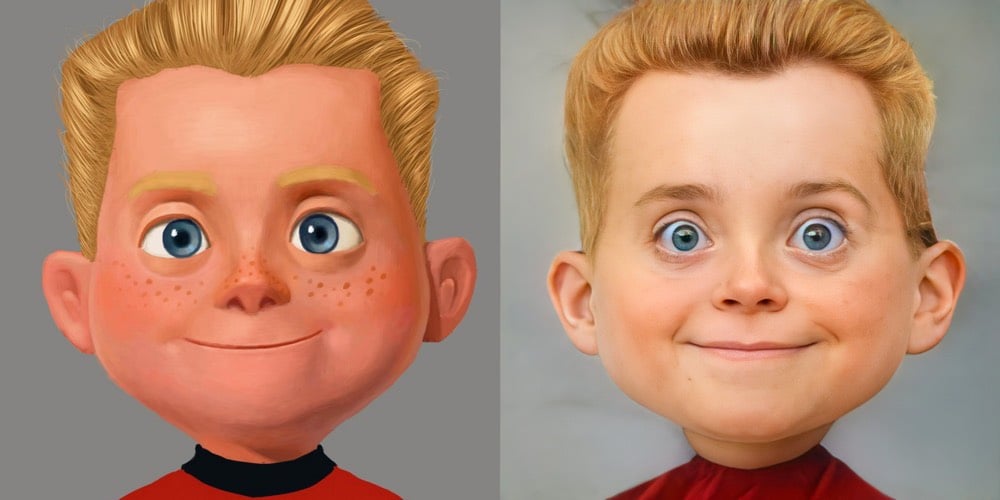

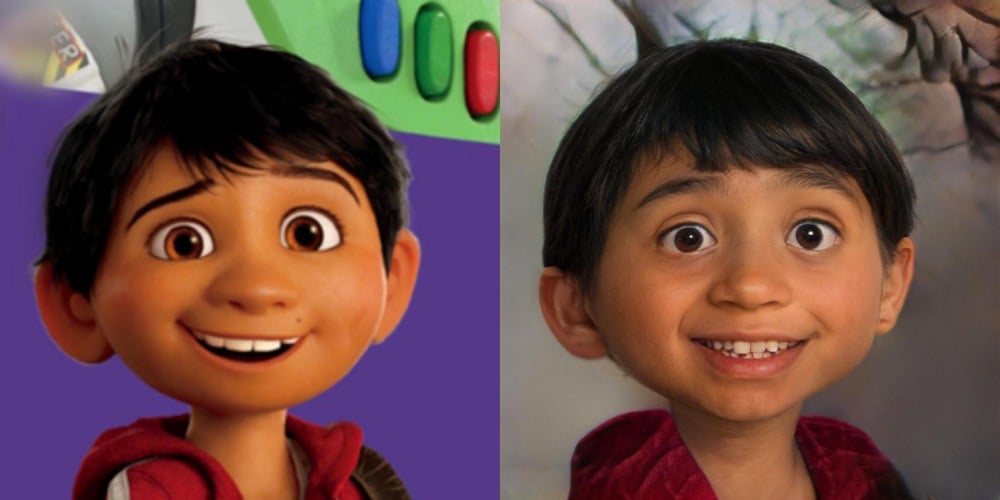
In response to a reader suggestion, Shipley fed the generated image for Dash back into the system and this happened:

I cannot tell where these images should live in the uncanny valley. You can see some similar experiments from Shipley here: a more realistic version of Miles from Spider-Verse, images of Frida Kahlo and Diego Rivera “reverse engineered” from paintings, and an image generated from a Rembrandt self-portrait.
“My Mustache, My Self”
This is a superb essay by Wesley Morris where he starts off talking about his quarantine mustache but ends up considering where he fits in on the broadening spectrum of Blackness, from Carlton Banks to Malcolm X.
My friend had identified a mighty American tradition and placed my face within it. Any time 20th-century Black people found themselves entangled in racialized peril, anytime the roots of racism pushed up some new, hideous weed, a thoughtful-looking, solemn-seeming, crisply attired gentleman would be photographed entering a courthouse or seated somewhere (a library, a living room) alongside the wronged and imperiled. He was probably a lawyer, and he was likely to have been mustached.
An Interface for Exploring Ed Ruscha’s Sunset Boulevard Street Views

Since 1965, American artist Ed Ruscha has been taking photos all along the length of Sunset Boulevard in LA. The Getty has made those photos available on the Getty Research Institute website and Stamen Design built this fantastic interface called 12 Sunsets for virtually cruising up and down the street.
This is so much fun to play with! You can use the mouse or arrow keys to drive, the spacebar to flip to the other side of the street, and you can change or add years to the display. It’s really interesting to add a bunch of different years to the display and then motor up and down the street to see what’s changed over the decades. It’s the perfect interface for this art.
Oh goody, the new 2021 human glands have been announced. “A team of researchers…has discovered what may be a set of previously unidentified organs: a pair of large salivary glands, lurking in the nook where the nasal cavity meets the throat.”
The NYPL’s Essential Reads on Feminism
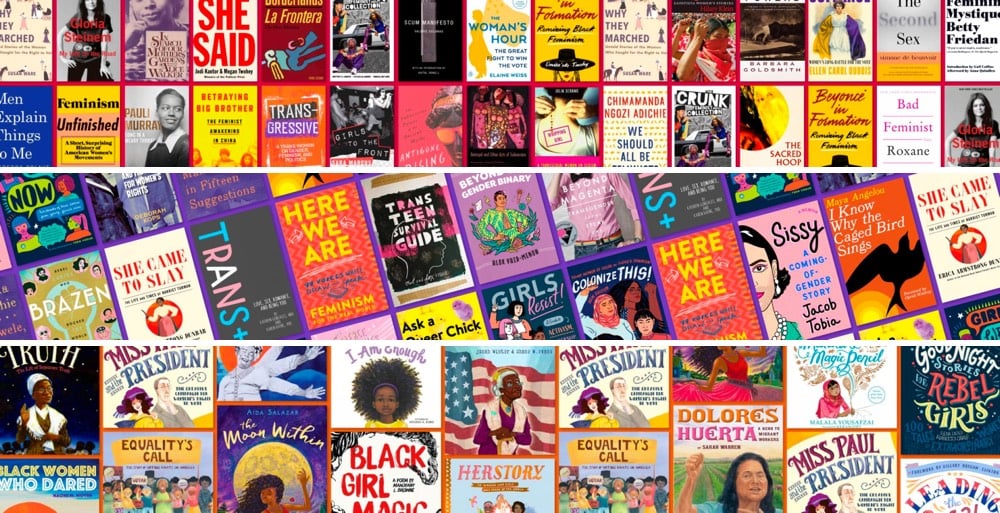
To mark the 100th anniversary of the ratification of the 19th Amendment to the Constitution that made some women eligible to vote in the United States, the New York Public Library is sharing its picks for Essential Reads on Feminism.
The list includes first-hand accounts and histories of the suffrage movement that chronicle both its successes and its limitations — particularly for women of color — as well as contemporary essays on how feminism intersects with race, class, education, and LGBTQ+ activism. From personal memoirs to historical overviews, featuring writing by seminal figures and lesser-known pioneers, the list traces the development of the feminist ideas that have powered the campaign for gender equality, in all its complexity and boldness. While far from complete, the list nevertheless provides a starting point for learning about the history of feminism and for exploring the issues and challenges that many women face today.
They’ve split the list into three main sections according to reader age: kids, teens, and adults. I’m going to highlight a few of the selections from each list here.
For kids:
Black Girl Magic by Mahogany L. Browne. “Black Girl Magic is a journey from girlhood to womanhood and an invitation to readers to find magic in themselves.”
Good Night Stories for Rebel Girls: 100 Tales of Extraordinary Women by Elena Favilli & Francesca Cavallo. My daughter tells me about the women she’s read about in this book all the time.
I Am Enough by Grace Byers. “We are all here for a purpose. We are more than enough. We just need to believe it.”
Malala’s Magic Pencil by Malala Yousafzai. “Nobel Peace Prize winner and New York Times bestselling author Malala Yousafzai’s first picture book, inspired by her own childhood.”
Shaking Things Up: 14 Young Women Who Changed the World by Susan Hood. “Fresh, accessible, and inspiring, Shaking Things Up introduces fourteen revolutionary young women — each paired with a noteworthy female artist — to the next generation of activists, trail-blazers, and rabble-rousers.”
For teens:
I Know Why the Caged Bird Sings by Maya Angelou. “Here is a book as joyous and painful, as mysterious and memorable, as childhood itself.”
Amazons, Abolitionists, and Activists: A Graphic History of Women’s Fight for Their Rights by Mikki Kendall. “Amazons, Abolitionists, and Activists is an indispensable resource for people of all genders interested in the fight for a more liberated future.”
Dear Ijeawele, or a Feminist Manifesto In Fifteen Suggestions by Chimamanda Ngozi Adichie. “Filled with compassionate guidance and advice, it gets right to the heart of sexual politics in the twenty-first century, and starts a new and urgently needed conversation about what it really means to be a woman today.”
Modern Herstory: Stories of Women and Nonbinary People Rewriting History by Blair Imani. “An inspiring and radical celebration of 70 women, girls, and gender nonbinary people who have changed — and are still changing — the world, from the Civil Rights Movement and Stonewall riots through Black Lives Matter and beyond.”
Rethinking Normal: A Memoir in Transition by Katie Rain Hill. “Rethinking Normal is a coming-of-age story about transcending physical appearances and redefining the parameters of ‘normalcy’ to embody one’s true self.”
For adults:
Bad Feminist by Roxane Gay. “A collection of essays spanning politics, criticism, and feminism from one of the most-watched young cultural observers of her generation, Roxane Gay.”
Beyoncé in Formation: Remixing Black Feminism by Omise’eke Tinsley. “In Beyoncé in Formation, Tinsley now takes her rich observations beyond the classroom, using the blockbuster album and video Lemonade as a soundtrack for vital new-millennium narratives.”
A Black Women’s History of the United States by Daina Ramey Berry & Kali Nicole Gross. “A vibrant and empowering history that emphasizes the perspectives and stories of African American women to show how they are — and have always been — instrumental in shaping our country.”
How We Get Free: Black Feminism and the Combahee River Collective by Keeanga-Yamahtta Taylor. “The Combahee River Collective, a path-breaking group of radical black feminists, was one of the most important organizations to develop out of the antiracist and women’s liberation movements of the 1960s and 70s.”
Men Explain Things to Me by Rebecca Solnit. “The antidote to mansplaining.”
We Should All Be Feminists by Chimamanda Ngozi Adichie. “Chimamanda Ngozi Adichie offers readers a unique definition of feminism for the twenty-first century, one rooted in inclusion and awareness.”
Again, you can access NYPL’s lists here.
I Was In Charge of the Deck Chairs On the Titanic, and They Absolutely Did Need Rearranging. “When the Titanic slid beneath the waves, taking hundreds of souls with her, she did so with the most becoming, loveliest deck amenities imaginable.”
Kamala versus Daenerys and the difference between mispronunciation & dispronunciation. “As far as I can tell, Americans have no problem saying ‘Daenerys Targaryen.’ Or ‘supercalifragilisticexpialidocious.’ Or ‘Hakeem Olajuwon.’”
NYC’s New Digital Subway Map
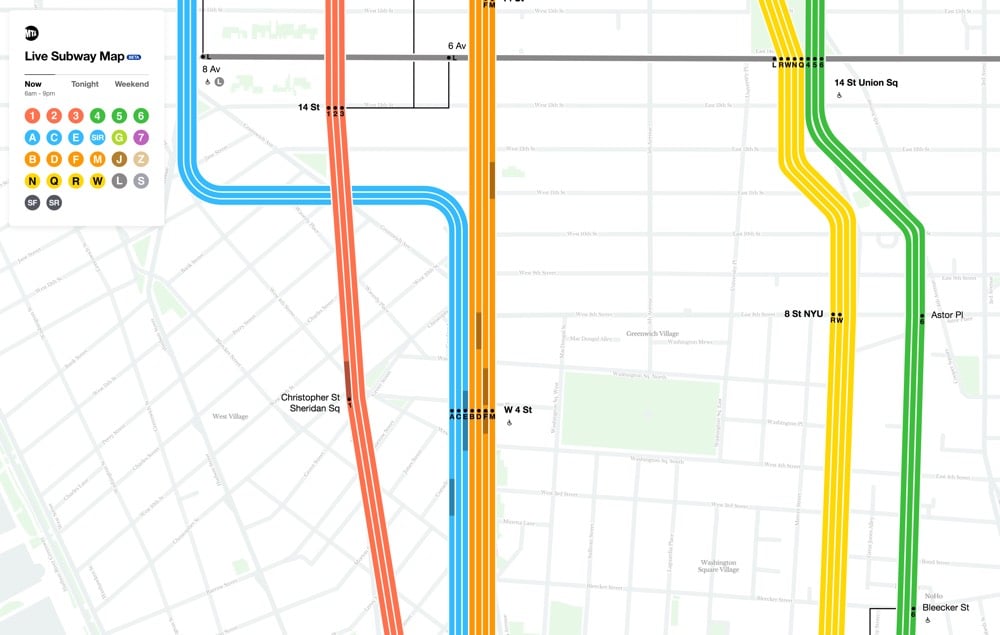
New York City has a new digital subway map that reflects the current status of the subway lines. And you can even see the trains moving, right on the map. (Finally!!) Visually, the new map combines the styles of two past maps, each beloved in their own way.1 Fast Company explains:
The first map is that by Massimo Vignelli, who simplified the snaking subway system into a clean diagram which traded geographic literality for graphical clarity. This elegant simplification turns the confounding subway into a logical system. But the main Vignelli map was scorned by New Yorkers because it wasn’t an actual map, and it was quickly replaced (though a permutation actually lives on as the MTA’s Weekender diagram, which signals weekend services). Meanwhile, the primary map the MTA uses today was created by Unimark International and Michael Hertz Associates. It’s more geographically accurate, but it actually condenses information that was in the Vignelli map. For example, it combines individual train lines such as the C, D, and E lines into singular trunks.
Here’s a video from filmmaker Gary Huswit that shows how the team came up with the new map:
Zooming the map in and out, you see different levels of detail, just like with Google or Apple Maps. I like it — a good combination of form and function.2
Update: A reader reminded me of designer Eddie Jabbour’s Kick Map of the NYC subway, which effectively melded the styles of the Vignelli and Hertz maps together more than 15 years ago.

What’s interesting is that the MTA explicitly rejected and criticized the Kick Map but ended up doing something quite similar with the new digital map. I think Jabbour’s effort deserves to be acknowledged here. (thx, nicolas)
I know as a lover of simplicity, beautiful design, and whatnot, I’m supposed to love the Vignelli map, but I never have. The Hertz map fits the utility of the NYC subway so much better.↩
Although I will say that the website in Chrome absolutely hammered the processor on my computer. It’s probably smoother on mobile?↩
From Scientific American (for unscientific Americans): Eight Persistent COVID-19 Myths and Why People Believe Them. It wasn’t lab-engineered, it’s not just the flu, natural herd immunity won’t work, etc.
It’s Reflective Fjord Season
This image-stabilized video of Tomasz Furmanek kayaking through the fjords of western Norway is almost obscenely beautiful. I want to go to there. (Really dislike the music though…this would have been so much better just with the ambient noise of the boat and paddle slipping through the water. Like this video.)
Succession’s Logan Roy and Gerri Kellman team up to advise Wisconsin voters on how to f*cking vote early, by f*cking mail, or in f*cking person. This is canon now, right?
A World of Calm
Well, this is interesting. A World of Calm is a new TV series from HBO Max based on a sleep & meditation app called Calm.
A timely antidote for our modern lives, each half-hour episode takes audiences on an immersive visual journey into another world. Building on the record-breaking success of Calm’s Sleep Stories™ — bedtime stories for grown ups with over 250m listens — each relaxing tale is designed to transform how you feel. Transporting the viewer into tranquility through scientifically-engineered narratives, enchanting music and astounding footage, to naturally calm your body and soothe the mind. Each story is brought to life by a different iconic voice.
Narrators include Lucy Liu, Mahershala Ali, Idris Elba, Zoe Kravitz, Keanu Reeves, and Kate Winslet. Based on the trailer (above) that hits a number of kottke.org pet topics — relaxing videos, soothing sounds, nature documentaries, aerial photography, craftsmanship — I will likely be spending some time with A World of Calm soon, possibly while high?
Sixty-two Films That Shaped the Art of Documentary Filmmaking. This is from Richard Brody, so you know going in that it’s not a list of the greatest hits (heavy hitters like The Thin Blue Line or Hoop Dreams aren’t on here).
World’s Fastest Production Car Reaches a Ludicrous 331 MPH on a Public Road
The SSC Tuatara has snatched the title of the world’s fastest production car away from its rivals by an absurd margin — and it wasn’t even going as fast as it could have.
After the satellite data from the onboard GPS system had been analyzed-the devices tracked two runs in opposite directions and calculated the average-Webb’s last dash came in at a staggering 331.15 mph. The final verified average was 316.11 miles per hour, handily beating both the Koenigsegg and the Bugatti records and cracking the metric milestone of 500 kilometers per hour just for good measure. In addition, the morning’s effort garnered records for the fastest flying mile on a public road (313.12 mph) and the highest speed achieved on a public road (331.15 mph).
How fast is that? “We were covering one and a half football fields each second.” *insert eyes-bugging-out emoji here* The cockpit video above is incredible. Just watch how smoothly and effortlessly the car accelerates right up to 331.15 mph before the driver lets off the gas — there was clearly plenty left. Indeed, the driver hadn’t even shifted into the car’s final gear.
A timeline map of where Covid-19 cases occurred in the US. NYC + cities at first, then the South, and more recently the Midwest/West.
The Way I See It, a Documentary Film About Former White House Photographer Pete Souza
Pete Souza was the White House photographer for Ronald Reagan and Barack Obama. Reflecting on his experience and the how the current President comports himself while in office, Souza published two books: Obama: An Intimate Portrait and Shade: A Tale of Two Presidents. Those books form the basis for a documentary directed by Dawn Porter on Souza and his work called The Way I See It.
Based on the New York Times #1 bestseller comes The Way I See It, an unprecedented look behind the scenes of two of the most iconic Presidents in American History, Barack Obama and Ronald Reagan, as seen through the eyes of renowned photographer Pete Souza. As Official White House Photographer, Souza was an eyewitness to the unique and tremendous responsibilities of being the most powerful person on Earth. The movie reveals how Souza transforms from a respected photojournalist to a searing commentator on the issues we face as a country and a people.
I didn’t know that Trump’s presidency is not really getting recorded photographically as past presidencies have, but I’m not surprised.
The film was shown on MSNBC the other day…I don’t know if they’re rerunning it or what. It’s also out in theaters but with many of those still closed, I assume it’ll be out on streaming at some point soonish? (Update: According to the MSNBC schedule, it looks like it’s re-airing at midnight on Friday.)
What A Summer Of COVID-19 Taught Scientists About Indoor vs. Outdoor Transmission. “If there is one thing we can definitively state, it’s that this virus is much, much less likely to spread outdoors than in.”
From the NY Times, a great profile of the inspiring Angela Davis. “As a bridge between the past and present eras of protest, Davis can explain both what went right and wrong while also helping to shape the future.”
Huge Butterfly Murals
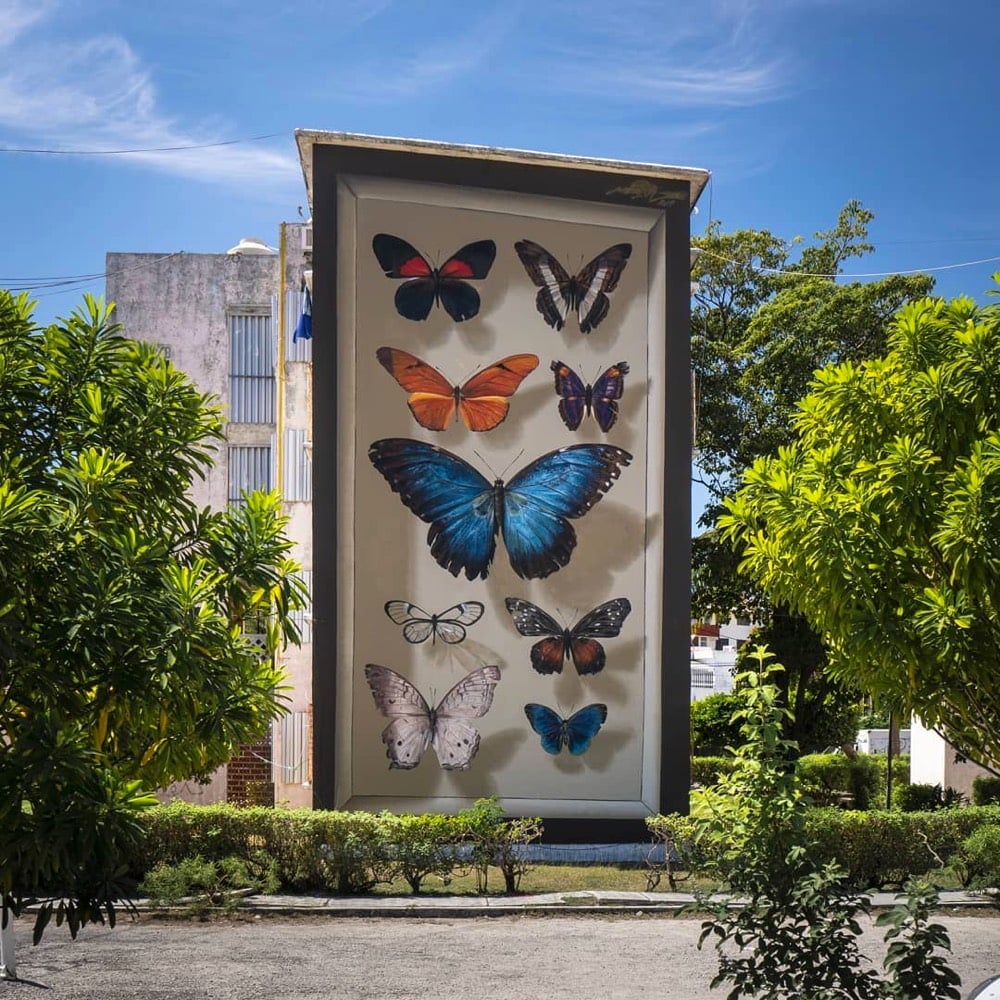
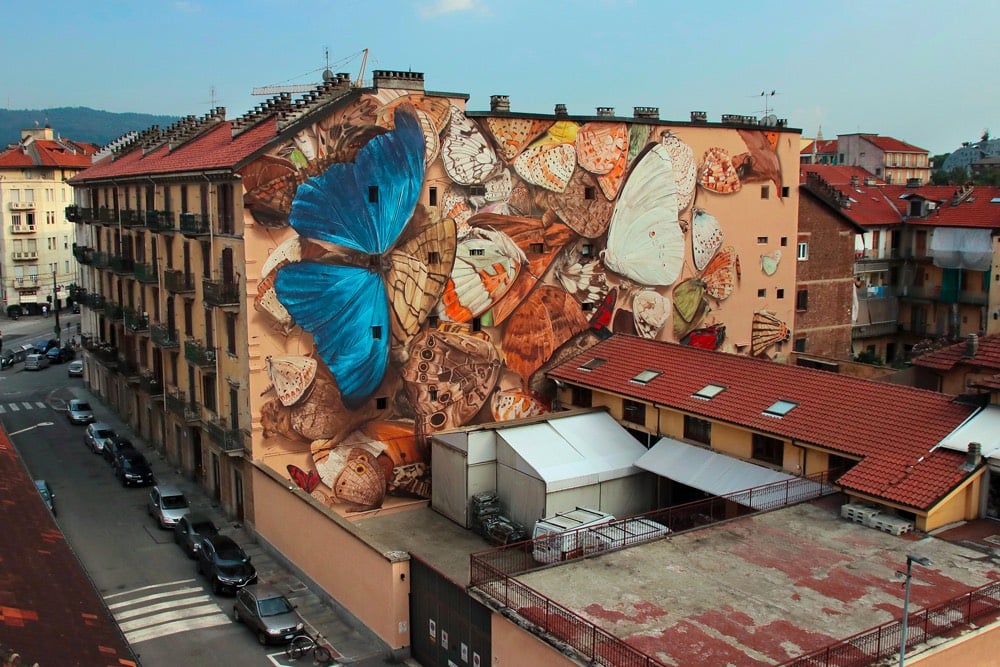
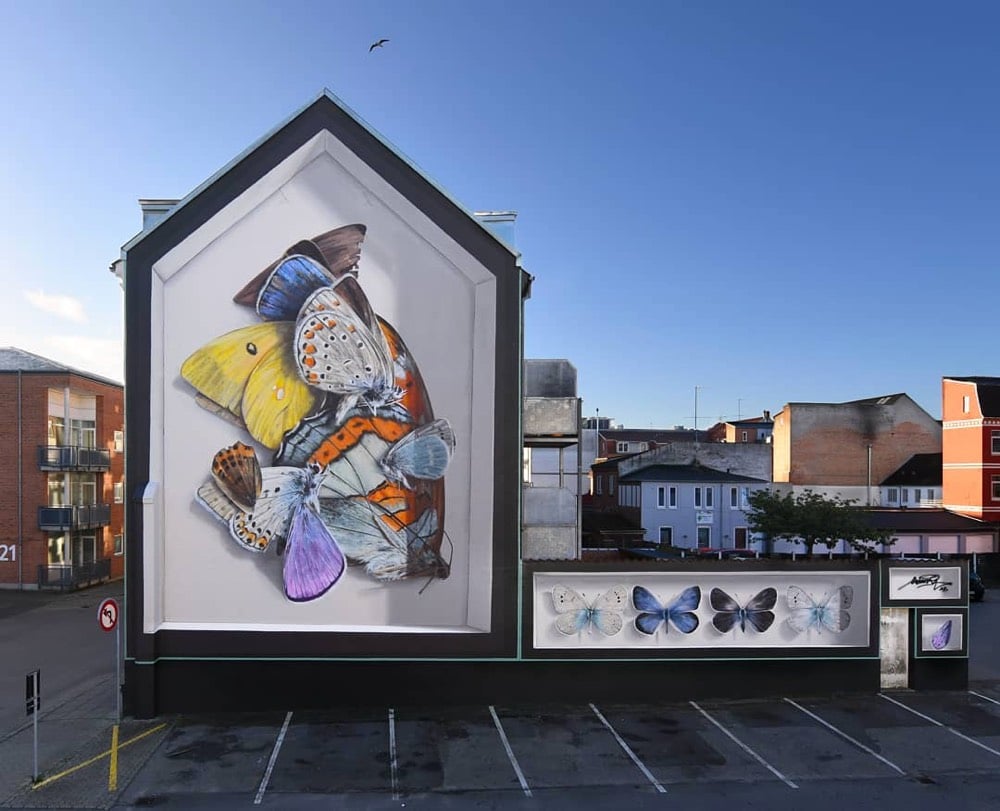
I love these building-sized murals featuring butterflies by French street artist Mantra (Instagram). From a Colossal post about the artist:
In a conversation with Colossal, Mantra said he’s harbored a lifelong fascination with entomology that stems from spending hours in French gardens and bucolic areas as a kid. “As a child, I was interested, curious, and focused on the small life forms in those places,” he says. His current practice hearkens back to those carefree hours and connects with an adolescent desire to become a naturalist. “My approach is as a scientist,” the artist says, noting that education about environmental care and issues is part of the goal.
Although Mantra considers all insects and natural life beautiful and crucial to maintaining biodiversity, the focus on butterflies revolves around his artistic ambitions because the vivid creatures allow him to experiment with color, shape, and texture. Each specimen is rendered freehand before the artist adds detail and the illusory shadows that make them appear three-dimensional. By painting various Lepidoptera species again and again, the artist is “repeating a mantra,” a detail of his practice that informs the moniker he works under.
The Swedish COVID-19 Response Is a Disaster. It Shouldn’t Be a Model for the Rest of the World. “From early on, the Swedish government seemed to treat it as a foregone conclusion that many people would die.”
Coronavirus in Africa: Five reasons why Covid-19 has been less deadly than elsewhere. “The continent’s strength lay in its tried and tested community health systems.”
Which states had the best pandemic response? “If the country as a whole had the same per capita death rate as Vermont, the nationwide death toll would be 30,000 instead of more than 215,000.”
Charming Local Covid-19 Social Distancing Signs
Public health safety measures don’t have to be bureaucratic, dour, and oppressive. They can even be fun. This is a sign from my local hardware store here in Vermont reminding shoppers to social distance:
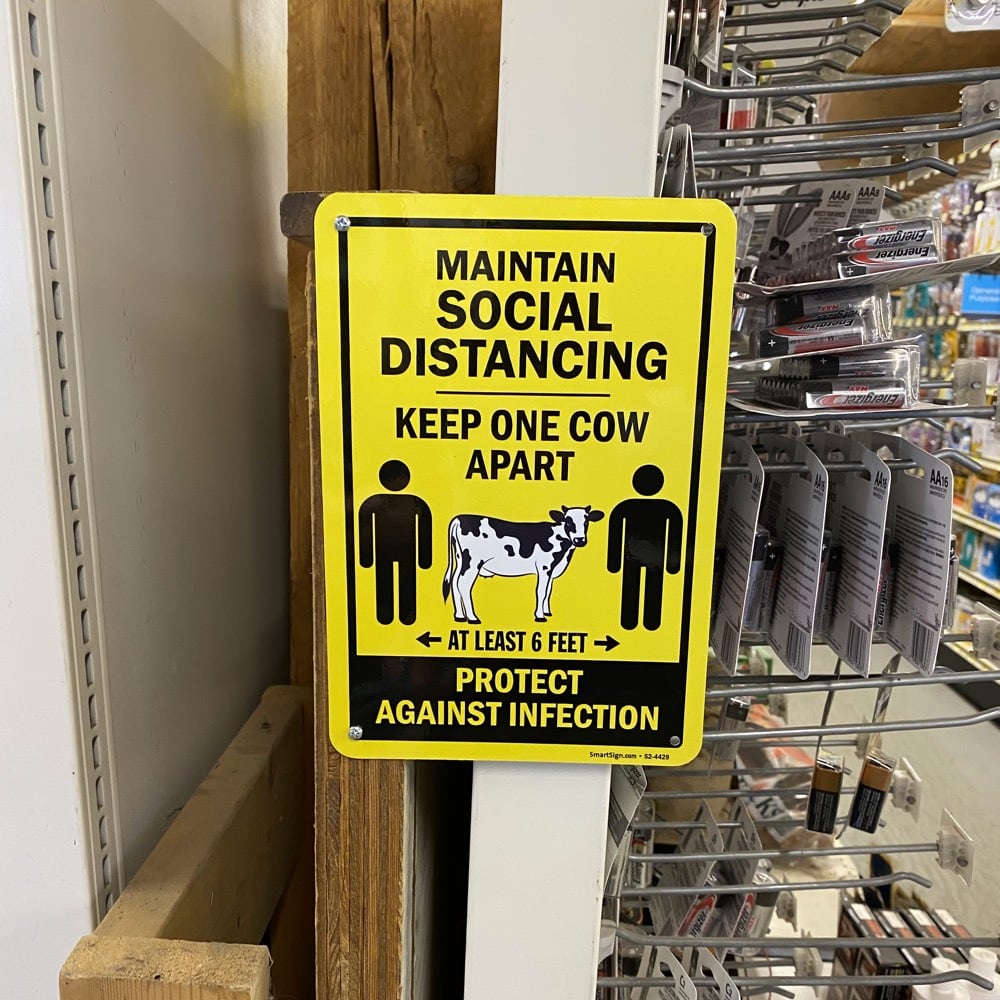
Journalist Rebecca Boyle recently asked her followers to share their local Covid-19 signage and they responded with some great examples.
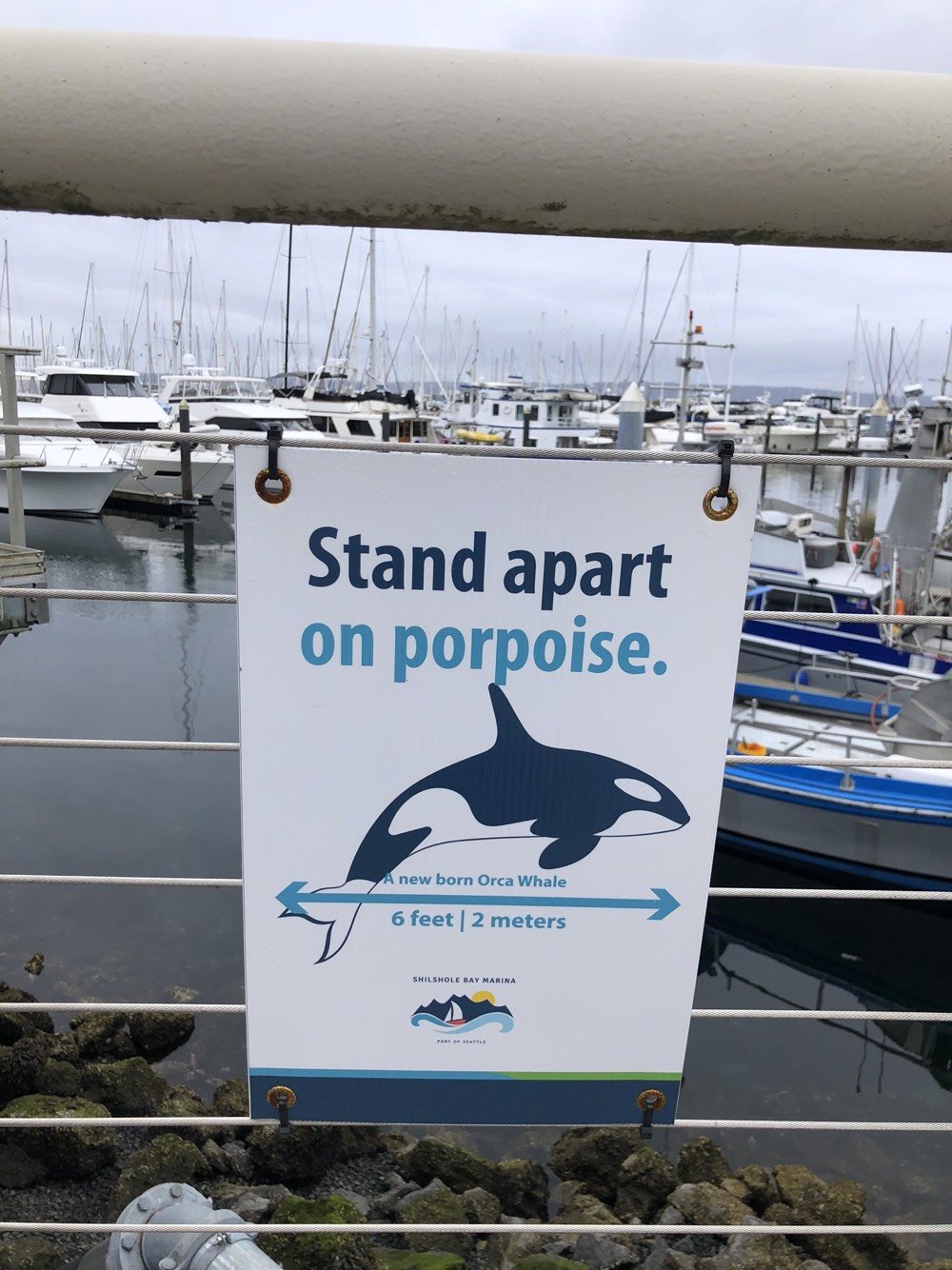
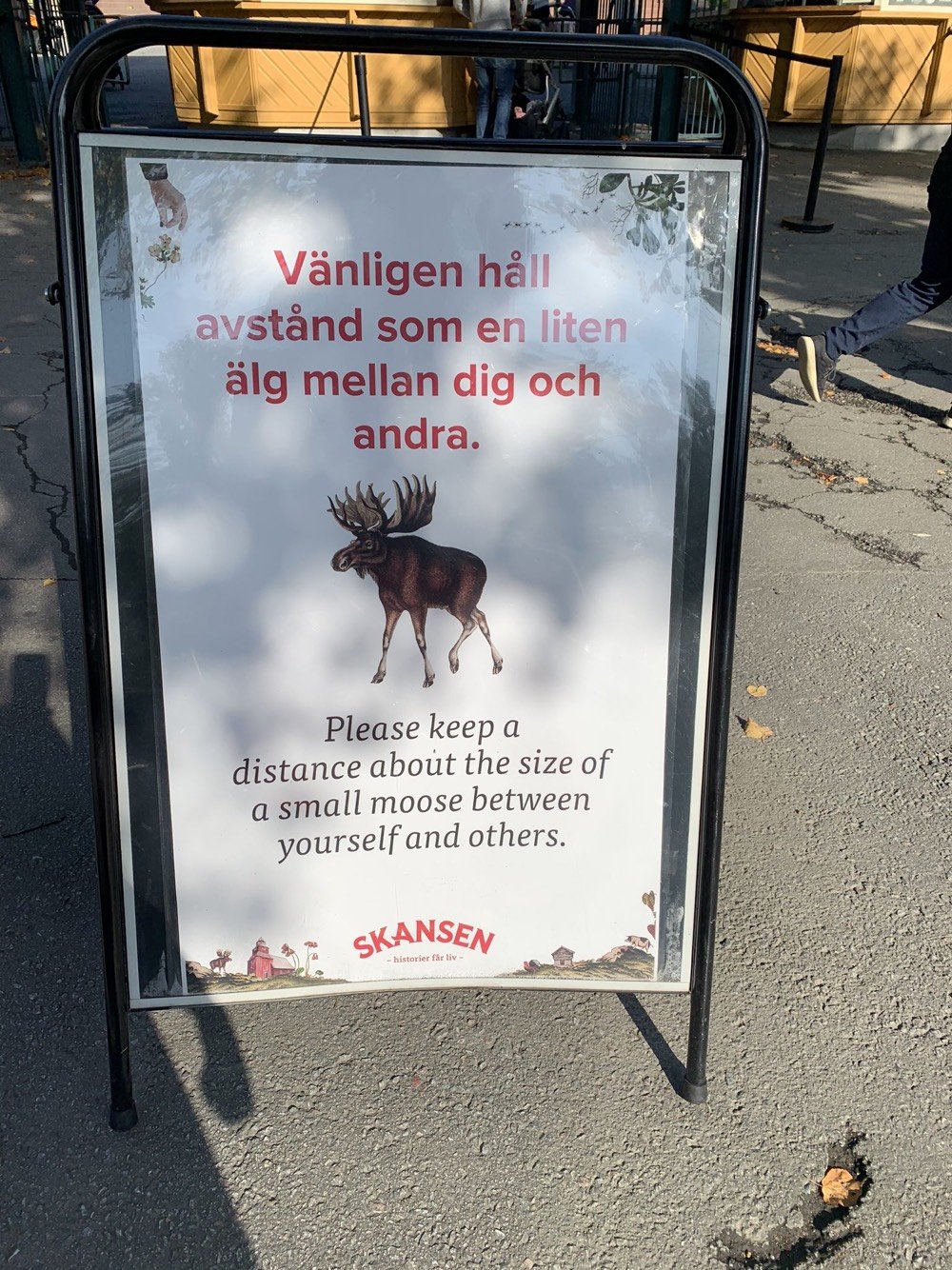
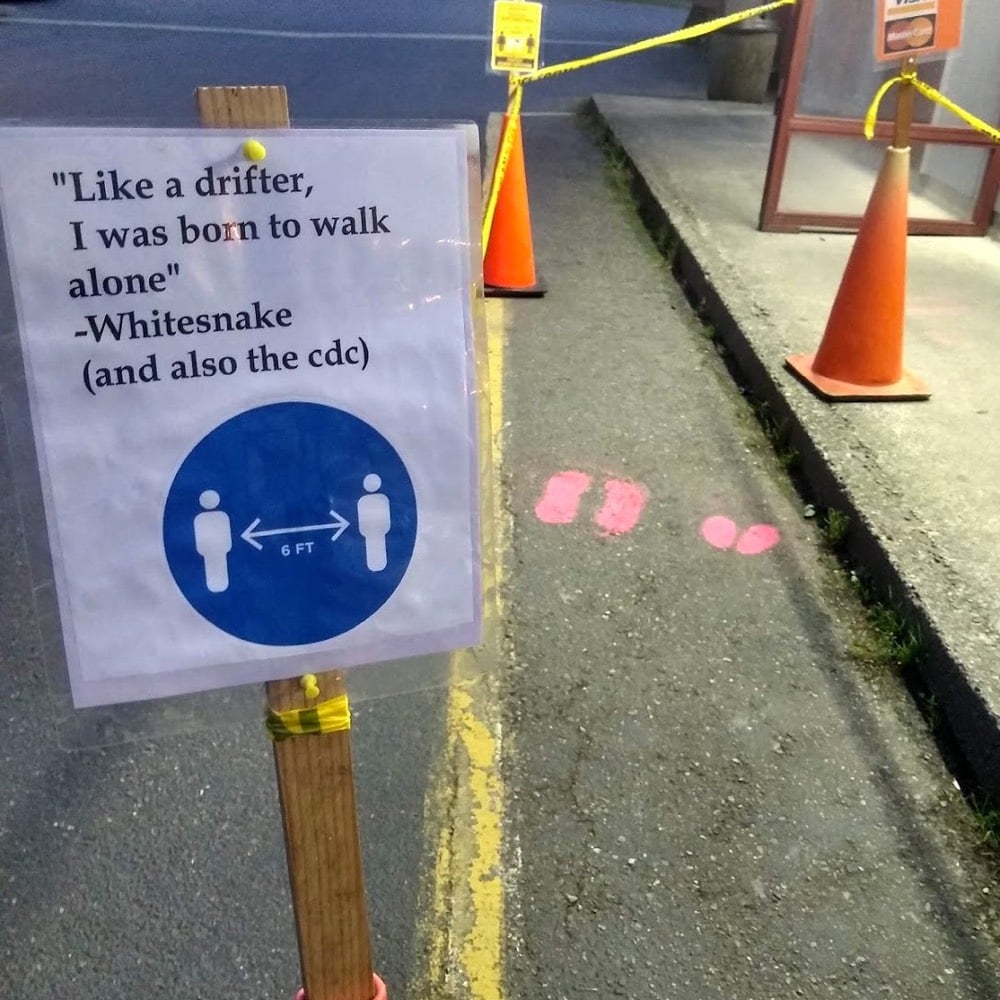
This homage to the Ministry of Silly Walks might be my favorite:
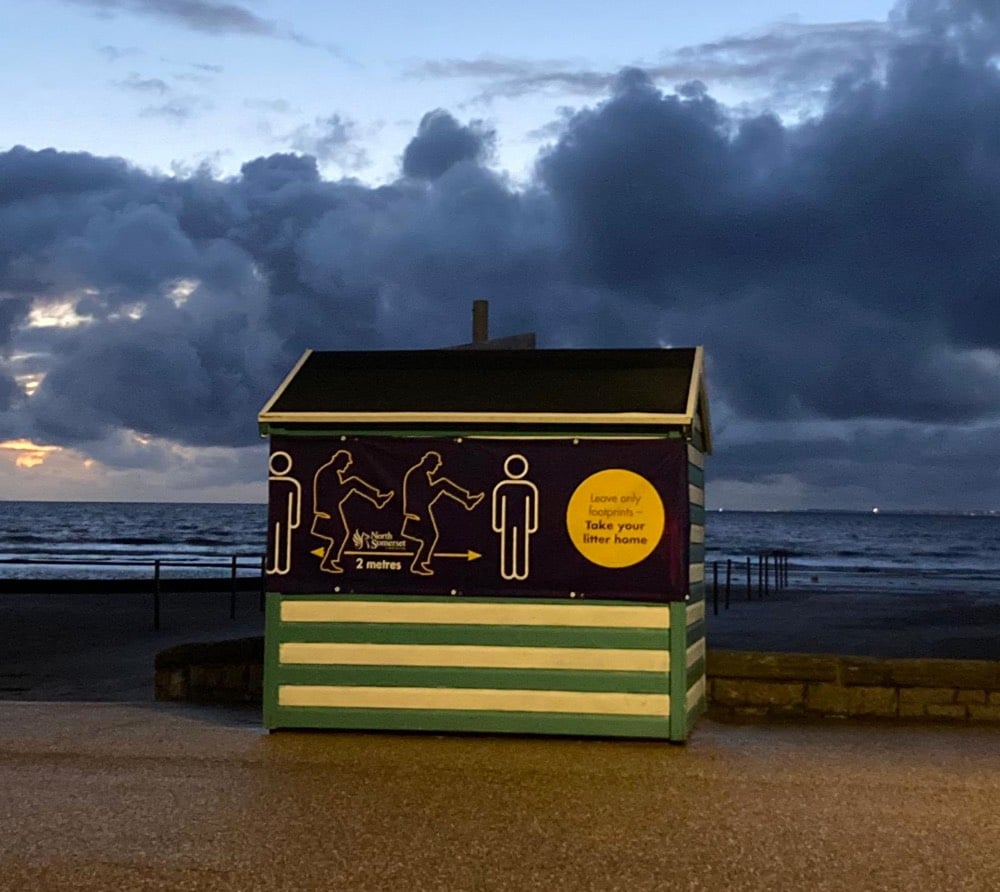
You can scroll through the whole thread for many more.
Herd immunity without a vaccine = mass murder. “The real death toll needed to reach herd immunity could far exceed one million.”
Inside the Fall of the CDC. “How the world’s greatest public health organization was brought to its knees by a virus, the president and the capitulation of its own leaders, causing damage that could last much longer than the coronavirus.”
How to Kick Your Phone Addiction Using Stop-Smoking Techniques
I don’t know if you’ve been listening lately, but yesterday’s episode of Kottke Ride Home was a particularly good one.
I was amused by the jetpack story (as well as Casey Niestat’s denial) and the idea that there’s a 50/50 chance we’re all living in a simulation is right up my alley. But I was most interested in the segment on how we can curtail our phone usage using proven techniques learned from people who have successfully quit smoking (aka the thing that people did with their hands when they had free moment before phones came along).
From the article by McKinley Valentine that Jackson highlighted:
I tried turning notifications off on every app. I just got anxious and opened the apps more often.
I tried deleting the apps that caused problems-social media, news, messages-from my phone. I ended up just accessing them in the browser.
I tried using apps like Stay Focused to block my access. I’d just disable them.
I tried just not checking my phone — the cold turkey method — and folks, it didn’t go great. All it did was add a layer of guilt to my bad habit and sour mood.
I thought: I have to get smarter about this. Who knows about addiction? What addiction has been studied in-depth, for decades, with an absolutely massive group of experiment subjects, to establish the best-practice methods? Cigarettes!
Valentine tried three main methods to kick her phone addiction habit: substitution, urge-surfing, and following the techniques in Allen Carr’s Easy Way to Stop Smoking. Carr’s advice was the most effective:
Carr notes that there is a huge disconnect between what we want and what we actually enjoy. They’re different neurological processes. That’s why you can desperately crave, for example, an entire blueberry cheesecake, but when you actually eat it, it’s only OK. Or why you often don’t feel like going out with your friends at all — it seems like kind of a hassle — but when you actually see them, you have an amazing time.
So Carr recommends working to really notice and internalise that disconnect. He tells smokers to pay attention to their next cigarette. It’s like mindfulness but for noticing the unpleasantness. How does it taste? Not, “how did you imagine it would taste when you were craving it,” but how does it actually taste? Does it smell nice? Do your hands smell nice? How do you feel — do you actually feel more relaxed, or do you feel worse?
Wow, “a huge disconnect between what we want and what we actually enjoy”…boy, have I observed that in my life many times. Gonna totally use this on some of my less constructive pandemic coping habits… (via kottke ride home)
Alan Taylor has been curating photos online for so long that you kinda forget how good he is at it. Each photo here is related to the previous photo either visually, thematically, or metaphorically. Fun to figure out the connections.
What I’ve Learned From Having A Trans Partner. “My partner doesn’t want his body. But I do.”
Tiny Forest? Big Vintage Tech?

Some combination of vintage tech, nature, the ambiguous scale, fog, and color palette in this digital image by Eric Mack is really tickling my brain in all the right ways today. (via @FedeItaliano76)
A new analysis published in JAMA puts the number of excess deaths in the US between March 1 and August 1 at 225,530. Only ~150K were officially attributed to Covid-19 (so the true death toll is 50% more than the “official” count).
Was reminded of the limits of self-preservation by this Atul Gawande interview: Trump could have easily won re-election had he taken even moderately effective action against Covid-19 in March or April. It was a gimme and he just. couldn’t. do it.
The Real Trolley Problem
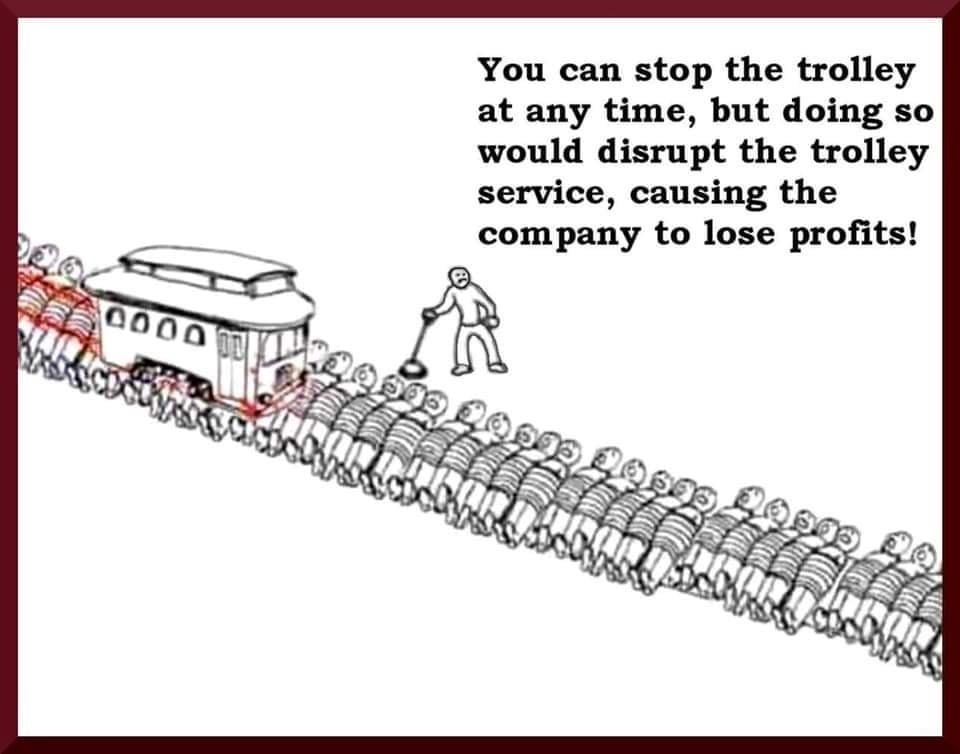
The trolley problem is an ethical thought experiment that’s fun to think and argue about but is often not that applicable to real-world situations (and has been memed to death in recent years). However, I think this one has a certain resonance to with current events.
It’s a Dialect Quiz!
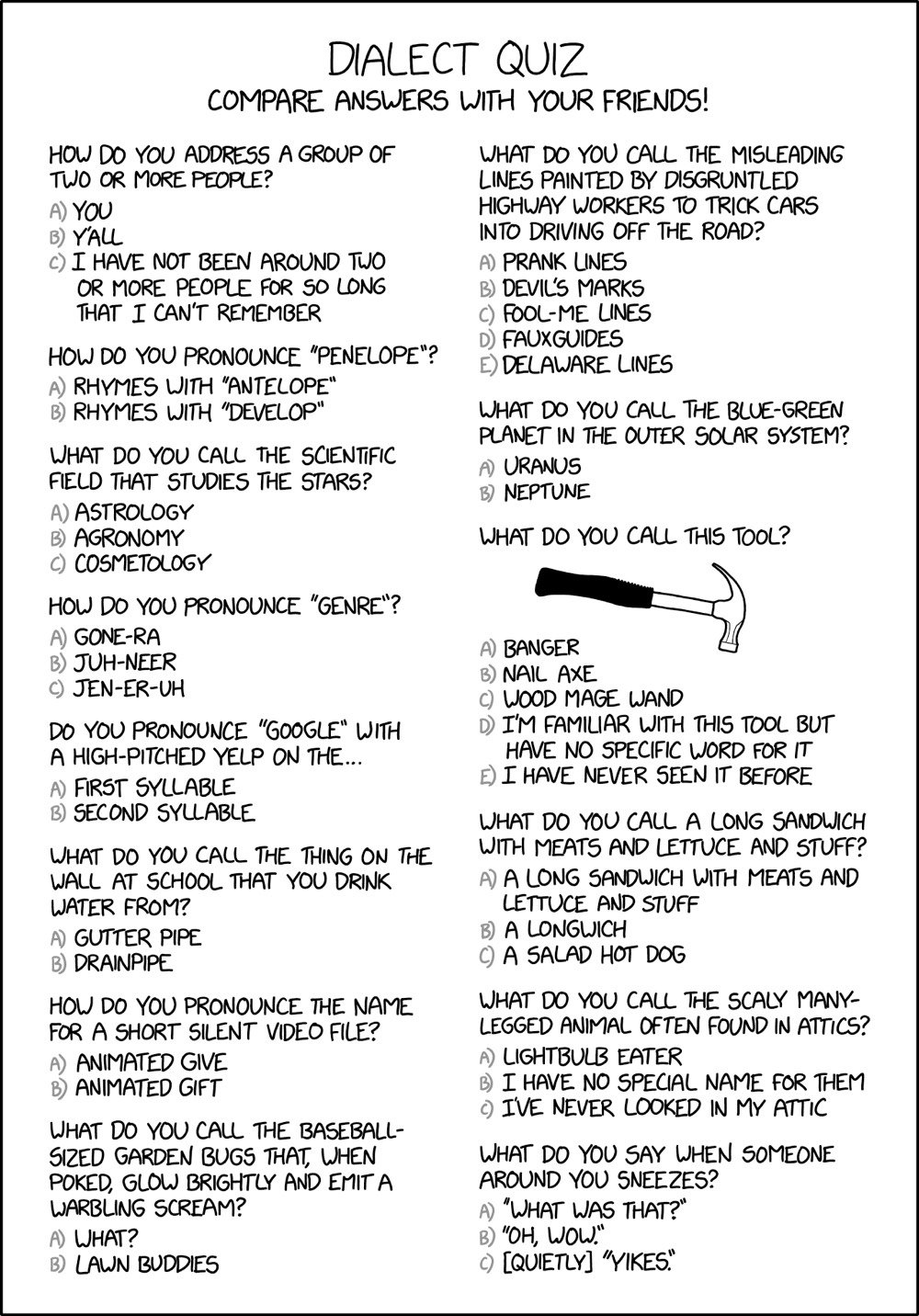
Remember when dialect quizzes and maps were a thing? XKCD is joining the fun with their own quiz. Reader, I giggled when I got to “lawn buddies” and full-on laughed at “longwich”. Longwich is totally going in my vocabulary arsenal.
A New Online Archive of 374 Treaties Between Indigenous Peoples and the United States

Thanks to an anonymous donation, the US National Archives has digitized and put online their collection of 374 treaties between indigenous peoples and the United States (and its predecessor colonies). You can also explore maps and see which tribes are associated with which treaties. I am sure the meaning of the words on these pages is different depending on who you ask but being able access them freely is a benefit to everyone. (via @CharlesCMann)
A list of the 10 greatest works of journalism of the past 10 years. Writers on the list include Ta-Nehisi Coates, Isabel Wilkerson, and Michelle Alexander. The NY Times’ 1619 Project is there too.
A Free Hyperlegible Typeface from the Braille Institute

Atkinson Hyperlegible is a free typeface developed by the Braille Institute and Applied Design Works that makes text more readable for people with low vision.
“People may be surprised that the vast majority of the students who come to Braille Institute have some degree of vision,” says Sandy Shin, the institute’s vice president for marketing and communications. “They’re not 100% blind.”
Thus, most of the Braille Institute’s 37,000 clients across Southern California don’t depend on the dot-based Braille language. Instead, they rely on spoken-word tools and accessibility standards that encourage text publishers to think more carefully about the legibility of words on pages.
As you can see in the graphic above (taken from their summary PDF), Atkinson Hyperlegible’s letterforms are constructed so that each letter is as distinctive as possible so that it’s recognizable even when blurry or distorted by low vision. You can download Atkinson Hyperlegible on the Braille Institute site. (via print)
We Need to Reckon with the Aerosol Spread of Covid-19
A spin studio (aka an indoor gym with stationary bikes) in Hamilton, Ontario is dealing with an outbreak of Covid-19 stemming from one asymptomatic patron that has resulted in 69 positive cases so far, even though the studio “followed the rules”. From the CNN report:
SPINCO, in Hamilton, Ontario, just reopened in July and had all of the right protocols in place, including screening of staff and attendees, tracking all those in attendance at each class, masking before and after classes, laundering towels and cleaning the rooms within 30 minutes of a complete class, said Dr. Elizabeth Richardson, Hamilton’s medical officer of health, in a statement.
As the Washington Post reports, patrons were allowed to take their masks off while exercising:
Although Hamilton requires masks to be worn in most public settings, the law includes an exemption for anyone “actively engaged in an athletic or fitness activity.” In keeping with that policy, the studio, SPINCO, allowed riders to remove their masks once clipped into their bikes, and told them to cover up again before dismounting.
The problem here is that while the studio may have followed the rules, they were not the right rules. This outbreak appears to be another clear-cut instance of Covid-19 spread by aerosols. A group of people indoors, without masks, breathing heavily, over long periods of time in what I’m guessing is not a properly ventilated room — this is exactly the sort of thing that has been shown over and over again to be problematic.1 The science is there, but governments and public health agencies have not caught up with this yet. If you take the transmission by aerosols into account, the rules for gyms (and bars and restaurants) being open is that they should probably not be open at all — or if they are, they should be well-ventilated and the wearing of masks should be mandatory at all times.2 (via @DrEricDing)
To return once again to aerosol expert Jose-Luis Jimenez’s excellent smoke analogy, attending a spin class with an asymptomatic patron who is breathing heavily is like being in a room with someone who is furiously chain-smoking for an hour. Unless that room is extremely well-ventilated, everyone is going to be breathing in so much smoke.↩
And to compensate these businesses for their public service in remaining closed, they should be financially supported by the government. We cannot let these businesses, especially small businesses, and their owners go under, for people to lose their savings or go bankrupt, etc. as they help keep the rest of us safe. If we want to have bars and restaurants and gyms and movie theaters and concert venues on the other side of this pandemic, they have to be compensated for their sacrifice on our behalf.↩
Nature (the science journal) supports Joe Biden for US president. “We cannot stand by and let science be undermined. Joe Biden’s trust in truth, evidence, science and democracy make him the only choice in the US election.”
How Artisanal French Butter Is Made
In Brittany, France, Le Beurre Bordier still makes butter by hand using wooden machines. In this video, we travel to their small factory and meet artisan butter maker (and goofy chap) Jean-Yves Bordier to see how they make what some people call the best butter in the world.
To Jean-Yves, the malaxage is a more romantic way to make butter. At his workshop, everything is churned, kneaded, and shaped by hand.
Bordier is such a character, and it’s genuinely delightful to see how he thinks like an artist about his work. (via colossal)
Welcome to Fall, the Two Days Between Summer and Winter. “O.K., is that sleet? It’s sleeting now. And it says that tomorrow it’s supposed to be in the eighties. Then it’s going to snow. How is that possible?”
The Winners of the 2020 Wildlife Photographer of the Year


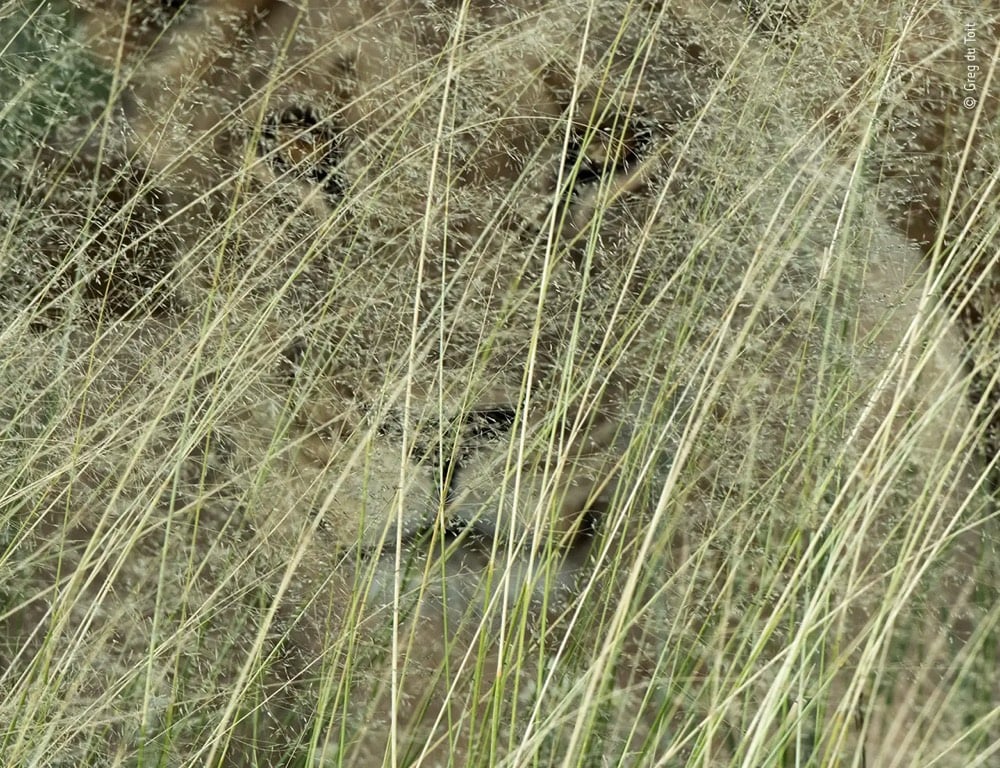
The winning photographs in the 2020 Wildlife Photographer of the Year contest have been announced by the Natural History Museum in London. Photos above by Shanyuan Li, Weiwei Zeng, and Greg du Toit. (via in focus)
LeBron James continues to expand our concept of excellence. “What Americans insist on seeing as a deficit, you remind us is part and parcel of our cheat code. You are Black abundance.”
Short Film Clip of a Snowball Fight from 1897
This is a short clip from 1897 of a snowball fight filmed by cinema pioneers the Lumière brothers in Lyon, France. This lovely little film has resurfaced recently after a retouched, motion-stabilized, upsampled, and colorized version was posted to Twitter. This doctored version was created using AI-powered software DeOldify. The colorized video does look strikingly modern, but it feels overclocked, overheated. I prefer the original version without all of the guesswork; as I wrote recently, I’ve grow weary of these AI-mediated films.
Wild World: a Hand-Drawn Geographic Map of the Earth
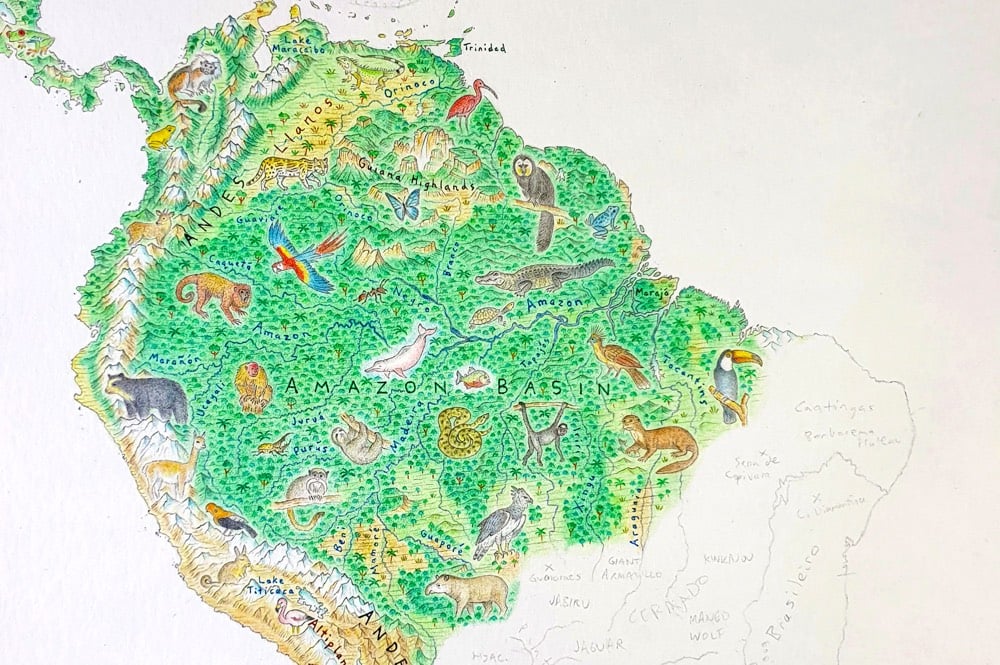
You may remember Anton Thomas from the huge hand-drawn map of North America that took him about 5 years to finish. His next effort, already well underway, is Wild World, a geographic map of the Earth.
Commenced in mid-2020, this is a brand new map of the world. Rather than the endless skylines and cultural features of North America: Portrait of a Continent, I wanted the wild character of Earth to shine.
While you won’t find cities or borders on this map, you will find geographic labels. This is important. From mountain ranges to deserts, rivers to rainforests, the labels here offer a detailed, accurate outline of Earth’s natural geography.
He’s aiming to complete the map by mid-2021.
“Your Civilisation Is Killing Life on Earth”
Nemonte Nenquimo, leader of the Waorani people in Ecuador: This is my message to the western world — your civilisation is killing life on Earth.
My name is Nemonte Nenquimo. I am a Waorani woman, a mother, and a leader of my people. The Amazon rainforest is my home. I am writing you this letter because the fires are raging still. Because the corporations are spilling oil in our rivers. Because the miners are stealing gold (as they have been for 500 years), and leaving behind open pits and toxins. Because the land grabbers are cutting down primary forest so that the cattle can graze, plantations can be grown and the white man can eat. Because our elders are dying from coronavirus, while you are planning your next moves to cut up our lands to stimulate an economy that has never benefited us. Because, as Indigenous peoples, we are fighting to protect what we love — our way of life, our rivers, the animals, our forests, life on Earth — and it’s time that you listened to us.
This is a great letter because it contains the force of truth. Nenquimo is a cofounder of the Ceibo Alliance, an indigenous-led organization working to defend indigenous territory and develop “viable solutions-based alternatives to rainforest destruction”, and was honored as one of Time’s 100 most influential people of 2020 (Leonardo DiCaprio penned her bio).
How a Road Trip Through America’s Battlegrounds Revealed a Nation Plagued by Misinformation. “Unlogic is not ignorance or stupidity; it is reason distorted by suspicion and misinformation…”
Sean Penn & Ann Young Lee used their non-profit organization CORE to build one of the largest coronavirus testing programs in the US. Free tests for 10s of 1000s of daily patients, results back in ~48 hours.
Vaccines May Help End the Pandemic. But Realistically, It’s Not Even Halftime Yet.
We’re all so goddamned tired of this fucking pandemic and so people are looking at the development and distribution of a vaccine as the thing that’s going to get us out of this (and quick). But realistically, that’s not what’s going to happen. Carl Zimmer wrote about some of the challenges with Covid-19 vaccines.
The first vaccines may provide only moderate protection, low enough to make it prudent to keep wearing a mask. By next spring or summer, there may be several of these so-so vaccines, without a clear sense of how to choose from among them. Because of this array of options, makers of a superior vaccine in early stages of development may struggle to finish clinical testing. And some vaccines may be abruptly withdrawn from the market because they turn out not to be safe.
“It has not yet dawned on hardly anybody the amount of complexity and chaos and confusion that will happen in a few short months,” said Dr. Gregory Poland, the director of the Vaccine Research Group at the Mayo Clinic.
See also Dr. Fauci’s belief that our best case scenario for returning to something close to normal life in the US is late 2021.
On Twitter, Zimmer also commented on something that I hadn’t really thought about: that all of these vaccines in development in the US are only for adults:
I wrote last month that no trials for kids had started. Update: still no US trials for kids. The goal of having shots ready for them by fall 2021 may be slipping further away.
From Zimmer’s article on the development of a kids’ vaccine:
Only if researchers discovered no serious side effects would they start testing them in children, often beginning with teenagers, then working their way down to younger ages. Vaccine developers are keenly aware that children are not simply miniature adults. Their biology is different in ways that may affect the way vaccines work. Because their airways are smaller, for example, they can be vulnerable to low levels of inflammation that might be harmless to an adult.
These trials allow vaccine developers to adjust the dose to achieve the best immune protection with the lowest risk of side effects. The doses that adults and children need are sometimes different — children get smaller doses of hepatitis B vaccines, for example, but bigger doses for pertussis.
You probably hate reading these kinds of articles; I know I do. But facing up to the reality of our situation, particularly here in the US where our political leadership has utterly failed in protecting us from this virus, is much better than burying our heads in the sand — that’s just not mentally healthy.
Aw, this sucks. Netflix announced that there will be no second season of The Dark Crystal: Age of Resistance. My kids and I really loved this show – I wish more people would have watched it.
Winning Images from the 2020 Nikon Small World Photomicrography Competition

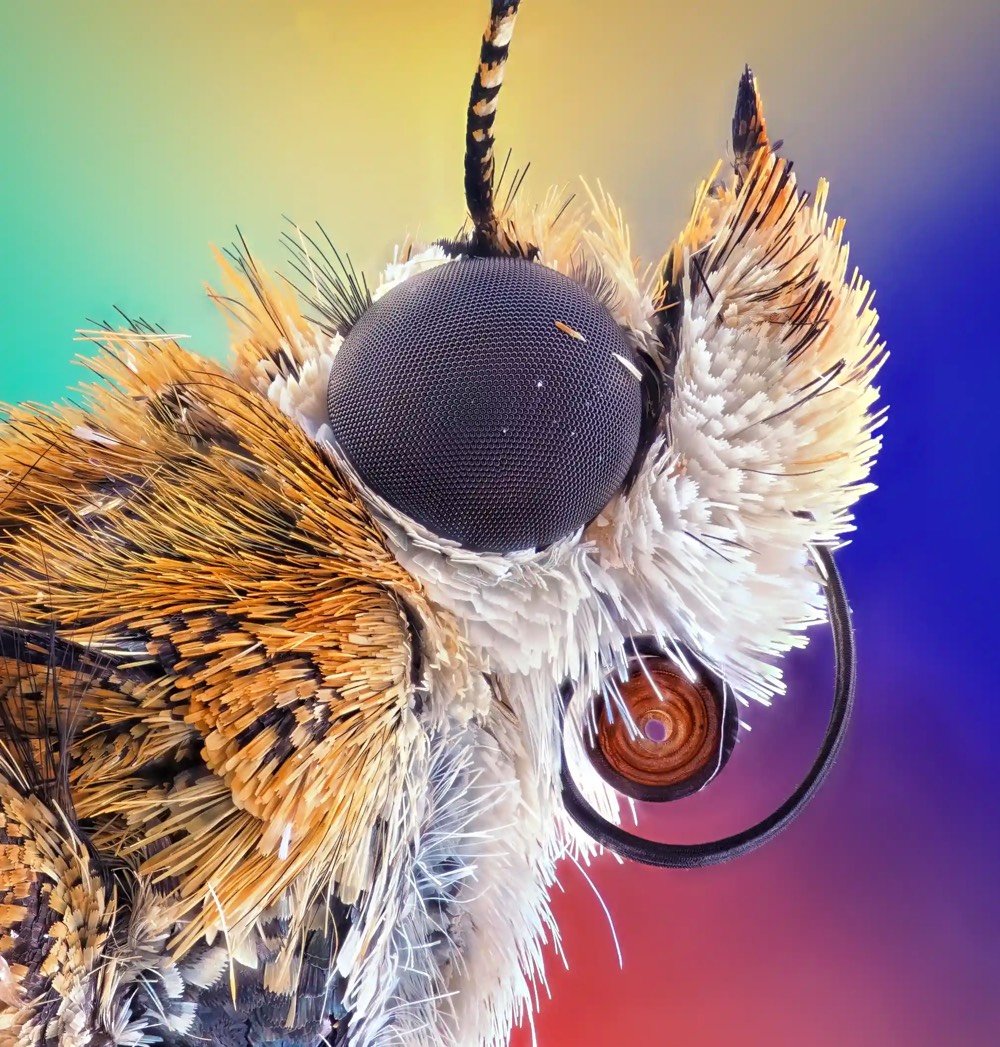

Nikon has announced the winners of its Small World Photomicrography competition for 2020. From top to bottom above, the development of a clownfish embryo by Daniel Knop, crystals by Justin Zoll, and a bogong moth by Ahmad Fauzan. You can check out the competition winners from past years, all the way back to 1975. (via @dnabeck)
Cristiano Ronaldo has Covid-19. It’s astounding that so many of the world’s best footballers have had it: Neymar, Zlatan, Mbappe, Pogba, Di Maria, Navas, Dybala. Fit or no, some are likely to have long-term health problems because of this.
Jackson Bird’s Transition Timeline
Jackson Bird, who kottke.org readers may know as the host of Kottke Ride Home, recently made a video showing his lifelong transition from the assignment he was given at birth to “the man I am today”.
Instead of photos, I used thirty years worth of home videos to share my story. I called this my Five Years On Testosterone video, but it could more accurately be called Thirty Years In Transition. This is three decades worth of what it looks like to be a transgender person. From childhood tomboy days to confusion and questioning to denial and finally coming out, starting hormones, changing my name, getting top surgery, and all of the moments in between. Not all of our stories are the same, far from it, but this is one story — my story. The story of how I became the man I am today.
What a great video and fantastic storytelling. Undertaking a journey in public like this cannot be easy; thanks for sharing this with us, Jackson. If you’d like to know more about his story, check out his memoir: Sorted: Growing Up, Coming Out, and Finding My Place.
Teens and young adults are having a hard time reasoning with QAnon-obsessed parents who have become radicalized by social media. “I love my dad, but at the same time I kind of hate him for this.”
Darren Aronofsky & His Cast Reunite for the 20th Anniversary of Requiem for a Dream
To mark the 20th anniversary of the debut of Requiem for a Dream, MoMA organized a virtual reunion of director Darren Aronofsky and the four principle cast members (Ellen Burstyn, Jared Leto, Jennifer Connelly, and Marlon Wayans) to talk about “the film and its impact on cinema and culture”. Would have loved to hear from cinematographer Matthew Libatique and Clint Mansell (who did the fantastic music for the film) as well, but even six-person online panels are a little unwieldy. (via open culture)
A Scientific Portrait of the SARS-CoV-2 Virus
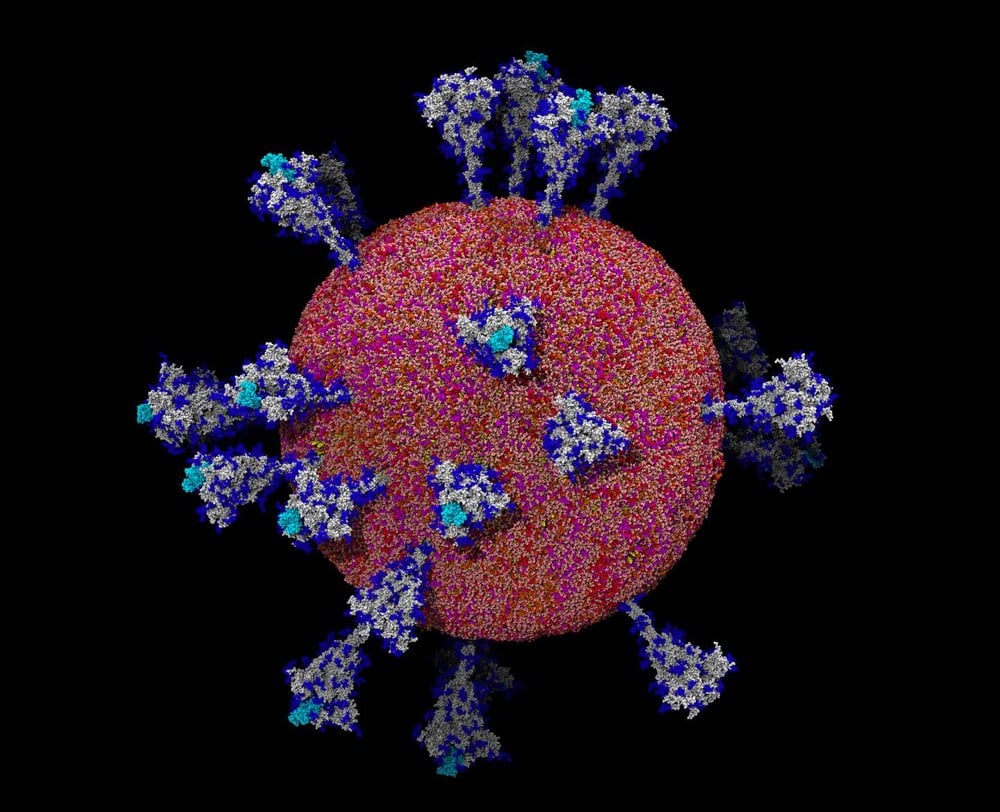
This is a great piece from Carl Zimmer about how much scientists have learned about SARS-CoV-2 through imaging, including how the virus works and prospects for treatment and a vaccine.
Thanks to the work of scientists like Dr. Li, the new coronavirus, known as SARS-CoV-2, is no longer a cipher. They have come to know it in intimate, atomic detail. They’ve discovered how it uses some of its proteins to slip into cells and how its intimately twisted genes commandeer our biochemistry. They’ve observed how some viral proteins throw wrenches into our cellular factories, while others build nurseries for making new viruses. And some researchers are using supercomputers to create complete, virtual viruses that they hope to use to understand how the real viruses have spread with such devastating ease.
I’ve been watching the lectures for MIT’s online Covid-19 class and the thing that has struck me most is just how much scientists have learned about the SARS-CoV-2 virus in such a short amount of time. To be clear, there are many things that they still do not understand about it (and viruses in general), but scientists know this thing upside down and backwards. The depth and breadth of their knowledge is so impressive and I wish more people were aware of it.
Winter Is Coming. Is It Safe to Socialize Indoors?
In an article that The Atlantic classifies as “politics” rather than “science” or “medicine”, Olga Khazan explores why, more than 8 months into the pandemic, Americans still have little idea about the safety of gathering with others indoors.
For months now, Americans have been told that if we want to socialize, the safest way to do it is outdoors, the better to disperse the droplets that spew from our mouths whenever we do anything but silently purchase grapefruit. But in many parts of the country, this is the last month that the weather will allow people to spend more than a few minutes outside comfortably. And next month, America will celebrate a holiday that is marked by being inside together and eating while talking loudly to old people.
In a nutshell, the lack of federal support/guidance/action is the main reason why people are still so confused about what safety measures to take to reduce their Covid risk:
Still, Ranney says, this [Covid risk] app is the kind of thing the federal government really should have developed by now. It’s odd that in a wealthy, industrialized country, a random researcher is the one designing a tool to keep citizens safe from public-health threats, using data she scraped from a newspaper.
One thing that Khazan doesn’t really get into is the whole aerosols thing, which in my mind is something that most people are still not familiar with, many local & state governments are not taking into account w/r/t recommended safety measures, and requires different risk guidance about the safety of the indoors than if we were just dealing with fomites & droplets. Again, from the excellent Time magazine piece by aerosol chemist Jose-Luis Jimenez:
When it comes to COVID-19, the evidence overwhelmingly supports aerosol transmission, and there are no strong arguments against it. For example, contact tracing has found that much COVID-19 transmission occurs in close proximity, but that many people who share the same home with an infected person do not get the disease. To understand why, it is useful to use cigarette or vaping smoke (which is also an aerosol) as an analog. Imagine sharing a home with a smoker: if you stood close to the smoker while talking, you would inhale a great deal of smoke. Replace the smoke with virus-containing aerosols, which behave very similarly, and the impact is similar: the closer you are to someone releasing virus-carrying aerosols, the more likely you are to breathe in larger amounts of virus. We know from detailed, rigorous studies that when individuals talk in close proximity, aerosols dominate transmission and droplets are nearly negligible.
If you are standing on the other side of the room, you would inhale significantly less smoke. But in a poorly ventilated room, the smoke will accumulate, and people in the room may end up inhaling a lot of smoke over time. Talking, and especially singing and shouting increase aerosol exhalation by factors of 10 and 50, respectively. Indeed, we are finding that outbreaks often occur when people gather in crowded, insufficiently ventilated indoor spaces, such as singing at karaoke parties, cheering at clubs, having conversations in bars, and exercising in gyms. Superspreading events, where one person infects many, occur almost exclusively in indoor locations and are driving the pandemic. These observations are easily explained by aerosols, and are very difficult or impossible to explain by droplets or fomites.
The science is there — it’s the lack of connection between scientists, public health experts & officials, and the government that continues to be a problem.
Facebook is finally updating their hate speech policy “to prohibit any content that denies or distorts the Holocaust”. Tho after years of being a welcoming place for harmful misinformation, this is like using a teaspoon to bail out a cruise ship.
Etsy has banned merchandise related to the death cult QAnon from their platform. A search on the site just now yielded zero results.
Podcast Recommendation: You’re Wrong About

My favorite podcast right now is You’re Wrong About, hosted by journalists Sarah Marshall and Michael Hobbes. So I was pleased to see Rachel Syme’s profile of the show in the New Yorker this morning.
Marshall and Hobbes are endlessly curious about their own blind spots, which they hunt down like truffle pigs set loose in a damp forest. Each brings a unique view and tone to the show; Marshall is more world-weary and sardonic, with a gravelly voice that sounds not unlike the caustic cartoon character Daria Morgendorffer. Hobbes is excitable and buzzing, often so eager to rattle off information that he speaks in full paragraphs. Together, they make up a kind of millennial Statler and Waldorf, heckling the shoddy journalism of the past. But even their response to the media is one of amusement, or droll resignation-they stay far away from the outrage that has become the pattern of public life. (Indignation would imply certainty, and certainty would cut against the core of their project.) In one episode, the hosts discuss the Y2K-bug scare, in which people feared that the year 2000 would cause computer systems — and society at large — to crash. Hobbes tells Marshall that people often use the subject as a bludgeon. “When we’re talking about climate change, people will bring up, like, Oh, we were worried about Y2K, too, and that turned out to be a hoax,” he says. “And somebody else will respond to that by saying, No, Y2K is an example of us coming together and fixing a problem.” After he’s done, Marshall playfully clears her throat. Then she says, “And, since we have now had two years of doing this show, I am able to extrapolate that perhaps the answer is no one is right.”
If you haven’t listened to the show before and your interest is piqued after reading that, I’ll give you some of my favorite episodes:
- Their still-ongoing series about The OJ Simpson Trial is simply fantastic. My only criticism of the excellent OJ: Made in America documentary was that they didn’t spend enough time on violence against women and You’re Wrong About is very persuasive in arguing that it was a central issue in this case.
- The four-part DC Snipers series is just as good as the OJ series. At the time, this was painted as radical Islamic terrorism but the actual motivations of the killers had much more to do with toxic masculinity than religion.
- Why Didn’t Anyone Go to Prison for the Financial Crisis? This episode is noteworthy in that they don’t actually talk that much about the circumstances of the 2008 financial crisis, but after listening you totally know the answer to the title’s question. I could have listened to an expanded 2-3 part series of this one.
- More recently, the two-part Tuskegee Syphilis Study is worth a listen.
But I’ve only been listening to the show for a little over a year and haven’t gone back into the archive that much. Other episodes that have gotten a lot of love from fans include Tonya Harding, Kitty Genovese, and Terri Schiavo. So much more to explore!
A profile of Dolly Parton in the New Yorker. “In the partisan world of country music, Parton’s persona defies categorization, at once down to earth and soaring high.”
I don’t like the language here that school reopening fears were “overblown”. With high Covid rates country-wide, parents & staff were correct to be concerned. We should be happy we prepared and were wrong. I hope the success continues.
Bicycle Ballet
Watch as artistic cyclist Viola Brand does all sorts of seemingly impossible bike tricks that look like ballet, all while dodging a massive chandelier inside an ornate European castle.
See also bicycle acrobat Lilly Yokoi performing some similar tricks back in 1965.
No, wearing a mask doesn’t make you sicker. So why do some people say that it does?
The Spell Checkers Agenda

The piece above is part of a series called Pluralism by artist Deborah Roberts — it’s a collage of dozens of Black names marked as misspelled by Microsoft Word’s built-in spell checker. I don’t know about you, but this makes me think about the neutrality of technology, how software is built, who builds it, and for whom it is designed.
I found this via Seeing Black Futures by Jenna Wortham and Kimberly Drew, which is adapted from their forthcoming book, Black Futures. You can check out more of Roberts’ work on her website or on Instagram.
Edward Tufte’s New Book: Seeing with Fresh Eyes
Data visualization pioneer Edward Tufte has published four books on the art and science of displaying information, including the seminal The Visual Display of Quantitative Information in 1983. To that set, he now adds a fifth book: Seeing with Fresh Eyes: Meaning, Space, Data, Truth. I couldn’t find a description of the book, but the website lists the table of contents and shows a few of the page layouts.
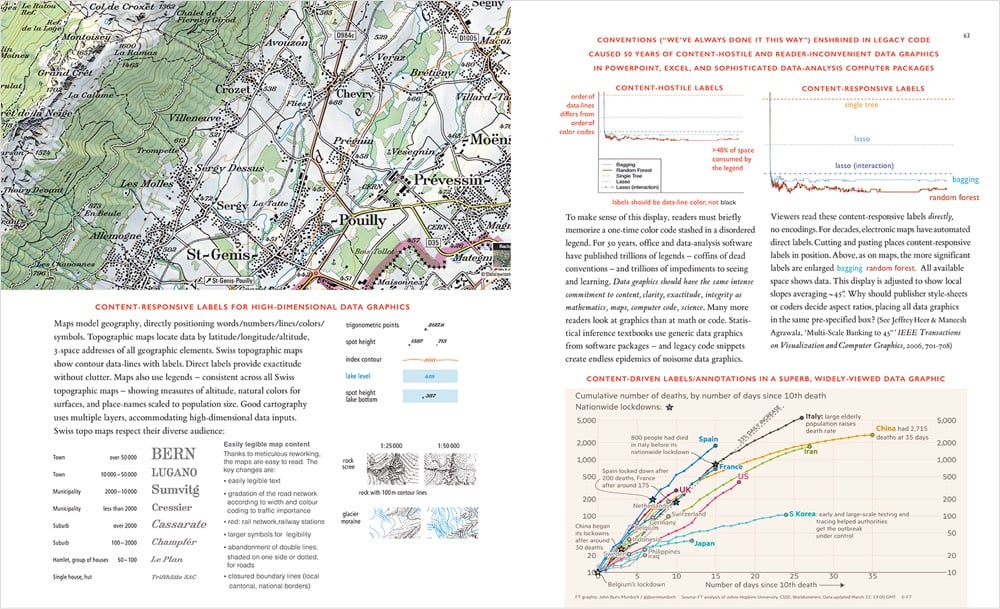
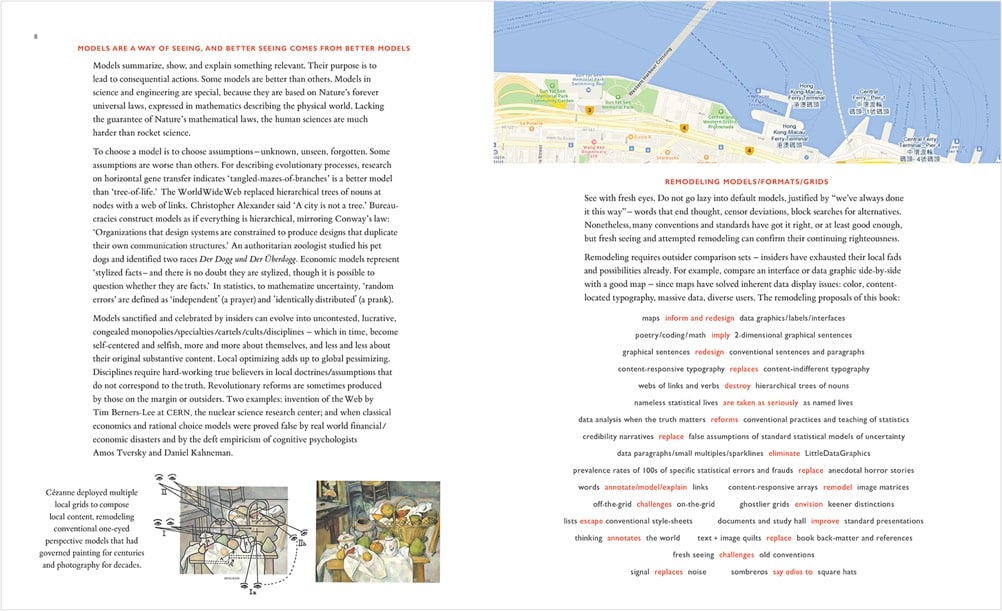
His previous four books are some of my favorites about design. You can only order Seeing with Fresh Eyes direct from his site, which says the book is shipping in mid-October. (thx, dewayne)
Paintings by Fire Ants


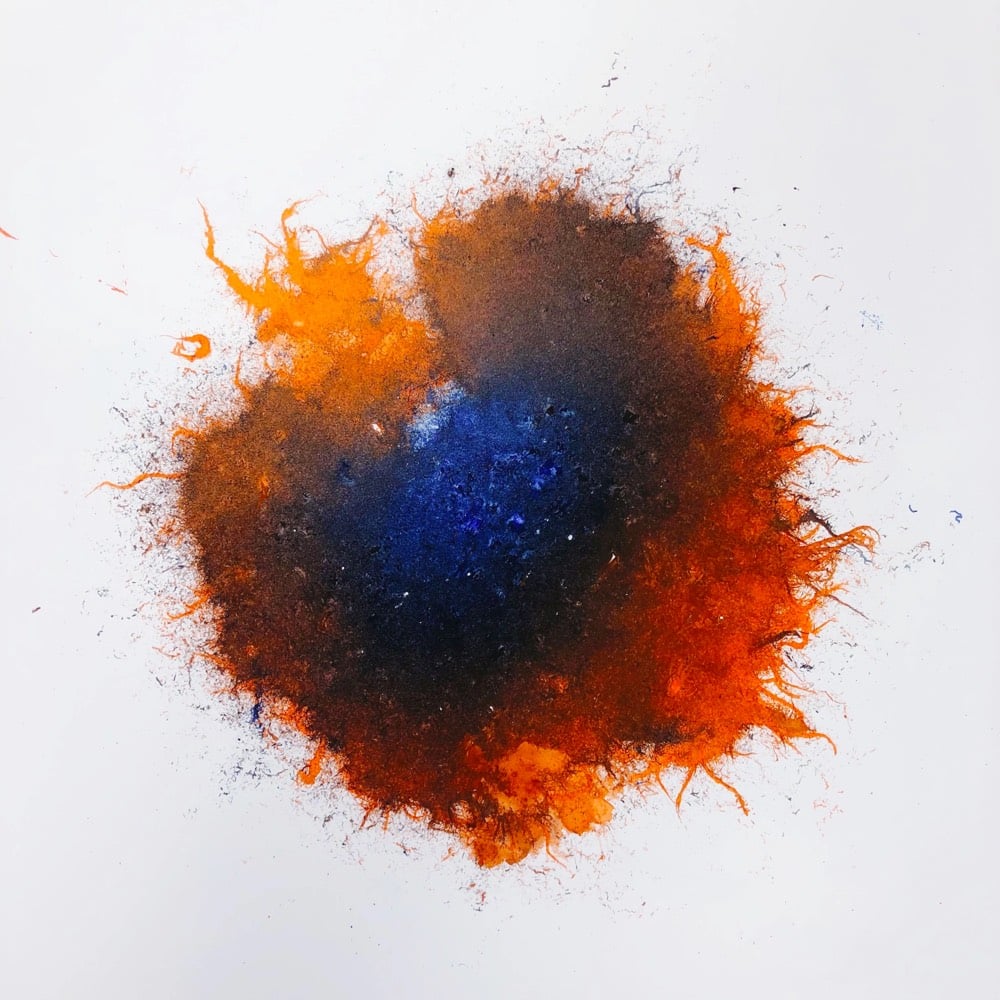
Ants use pheromone trails to signal to other ants to follow them to food or other desirable destinations. Inspired by this, entomology graduate student Horace Zeng dropped some of the fire ants he uses in his research into some paint pooled on canvases and watched them disperse, leaving behind these colorful patterns. Here’s a video of the ants doing their thing:
Kiss List: Writer/artist Galen Beebe kept track of every person she’s kissed and graphed the results & attributes of those encounters in a bunch of different ways, e.g. “my enjoyment level / how long I’d known them”.
Copaganda: The Biased Portrayal of Police in TV & Movies
YouTube channel Skip Intro is making a series of videos about copaganda, which Wikipedia defines as “the phenomenon in which news media and other social institutions promote celebratory portrayals of police officers with the intent of swaying public opinion for the benefit of police departments and law enforcement”. The introductory video embedded above introduces the concept and tracks the history of how police have been portrayed on TV in the movies. Two subsequent videos take a closer look at two contemporary police shows: Blue Bloods and Brooklyn Ninety-Nine.
See also Dan Taberski’s excellent podcast Running From COPS, which covers some of the same ground as the video series. (thx, david)
Update: Jacqui Shine wrote about the influence Dragnet had on how many Americans perceived the police: ‘Dragnet’ was straight up LAPD propaganda, on national TV for years.
When we see a cop on TV, we’re seeing the legacy of Dragnet. Everything we think we know about crime and law enforcement — and everything we believe about the police — bears the imprint of the show. It did no less than fashion the idea of modern policing in our cultural imagination. And, as viewers were reminded each week, all of it was true. But what most of us don’t know is that Dragnet was also calculated propaganda: the Los Angeles Police Department did far more than provide technical assistance, essentially co-producing the show.
Dr. Fauci: Earliest We’ll Be “Back to Normal” Is the End of 2021
A few weeks ago during the Q&A session after his lecture for MIT’s online biology class about the pandemic, Dr. Anthony Fauci shared his expert opinion on when things might return to “normal” in the US. Here was my paraphrased tweet about it:
With a very effective vaccine ready in Nov/Dec, distributed widely, and if lots of people take it (i.e. the best case scenario), the earliest we could return to “normal life” in the world is the end of 2021.
At the New Yorker Festival earlier in the week, Michael Specter asked him about a return to normalcy and Fauci elaborated a bit more on this timeline (starts ~10:22 in the video).
When are we gonna get back to something that closely resembles, or is in fact, normal as we knew it?
We’re already making doses, tens and hundreds of millions of doses to be ready, first at least, in graded numbers at the end of the year in November/December. By the time we get to April, we likely will have doses to be able to vaccinate anybody who needs to be vaccinated. But logistically by the time you get everybody vaccinated, it likely will not be until the third or even the beginning of the fourth quarter of 2021.
So let’s say we get a 70% effective vaccine, which I hope we will get, but only 60% of the people get vaccinated. There are going to be a lot of vulnerable people out there, which means that the vaccine will greatly help us to pull back a bit on the restrictions that we have now to maintain good public health, but it’s not going to eliminate things like mask wearing and avoiding crowds and things like that.
So I think we can approach normality, but I don’t think we’re going to be back to normal until the end of 2021. We may do better than that; I hope so but I don’t think so.
Leaving aside what “normal” might mean and who it actually applies to,1 there’s some good news and bad news in there. The good news is, they’re already producing doses of the vaccine to be ready if and when the phase 3 trials are successful. Ramping up production before the trials conclude isn’t usually done because it’s a waste of money if the trials fail, but these vaccines are so critical to saving lives that they’re spending that money to save time. That’s great news.
The bad news is that we’re not even halfway through the pandemic in the best case scenario. We’re going to be wearing masks in public for at least another year (and probably longer than that). Large gatherings of people (especially indoors) will continue to be problematic — you know: movie theaters, concerts, clubs, bars, restaurants, schools, and churches — and folks staying within small pods of trusted folks will likely be the safest course of action.
A change in national leadership in both the executive branch and Senate could change the outlook for the better. We could get some normalcy back even without a vaccine through measures like a national mask mandate/distribution, a real national testing & tracing effort, taking aerosol transmission seriously, and easing the economic pressure to “open back up” prematurely. We’re never going to do as well as Vietnam or Taiwan, but I’d settle for Greece or Norway.
Update: In an interview posted yesterday, Johns Hopkins epidemiologist Dr. Caitlin Rivers gives her best guess at a return to normalcy:
Topol: When do you think we’ll see pre-COVID life restored?
Rivers: I wish I knew. I’m thinking toward the end of 2021. It’s really hard to say with any certainty. We should all be mentally prepared to have quite a bit ahead of us.
It’s America. If we know anything by now about this country, it’s that access to healthcare and economic opportunity is going to apply unevenly to the people who live here. For instance, it’s likely that Black & brown communities, which have been disproportionately affected by the pandemic, may face difficulty in getting access to vaccines compared to wealthier, predominantly white communities.↩
Song 2 by Blur but Nintendo’s Mario Does the “Woo Hoos”
Today’s good, clean, uncomplicated fun is right here in the form of this video - it does what it says on the tin.
See also the melodica version of the “welcome to Jurassic Park” scene. (via laura olin’s newsletter)
Update: I knew there was some similar M83 thing that I’d seen recently and was forgetting about: Midnight City but with Nelson Muntz laughing. (via @dansays)
This statement from the editors of the New England Journal of Medicine is lukewarm. I guess we’re supposed to assume they are talking about the White House? (And Senate?) Name names, folks…don’t beat around the bush.
Accidentally Wes Anderson, the Book
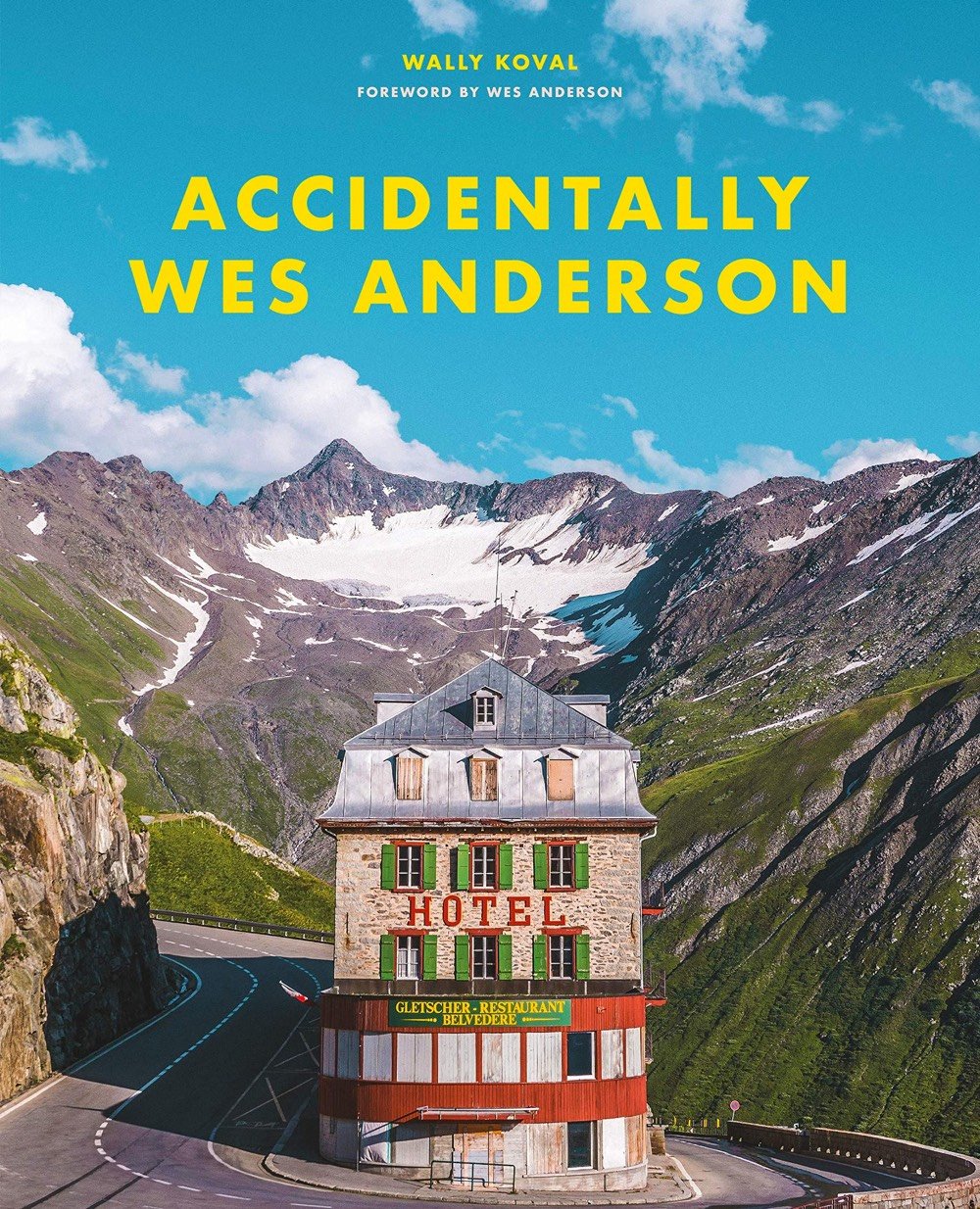
Inspired by the symmetry and color palettes of Wes Anderson’s movies, the Instagram account Accidentally Wes Anderson has been collecting and featuring photos from folks all over the world that wouldn’t look out of place in The Royal Tenenbaums or The Grand Budapest Hotel. The creators have turned it into a new book called Accidentally Wes Anderson, which features many of the best contributions from the account. It sounds like it’s kind of a travel book, a visually oriented Atlas Obscura.
Now, inspired by a community of more than one million Adventurers, Accidentally Wes Anderson tells the stories behind more than 200 of the most beautiful, idiosyncratic, and interesting places on Earth. This book, authorized by Wes Anderson himself, travels to every continent and into your own backyard to identify quirky landmarks and undiscovered gems: places you may have passed by, some you always wanted to explore, and many you never knew existed.
And while we’re here, I picked out a few of my recent favorites from their Instagram:
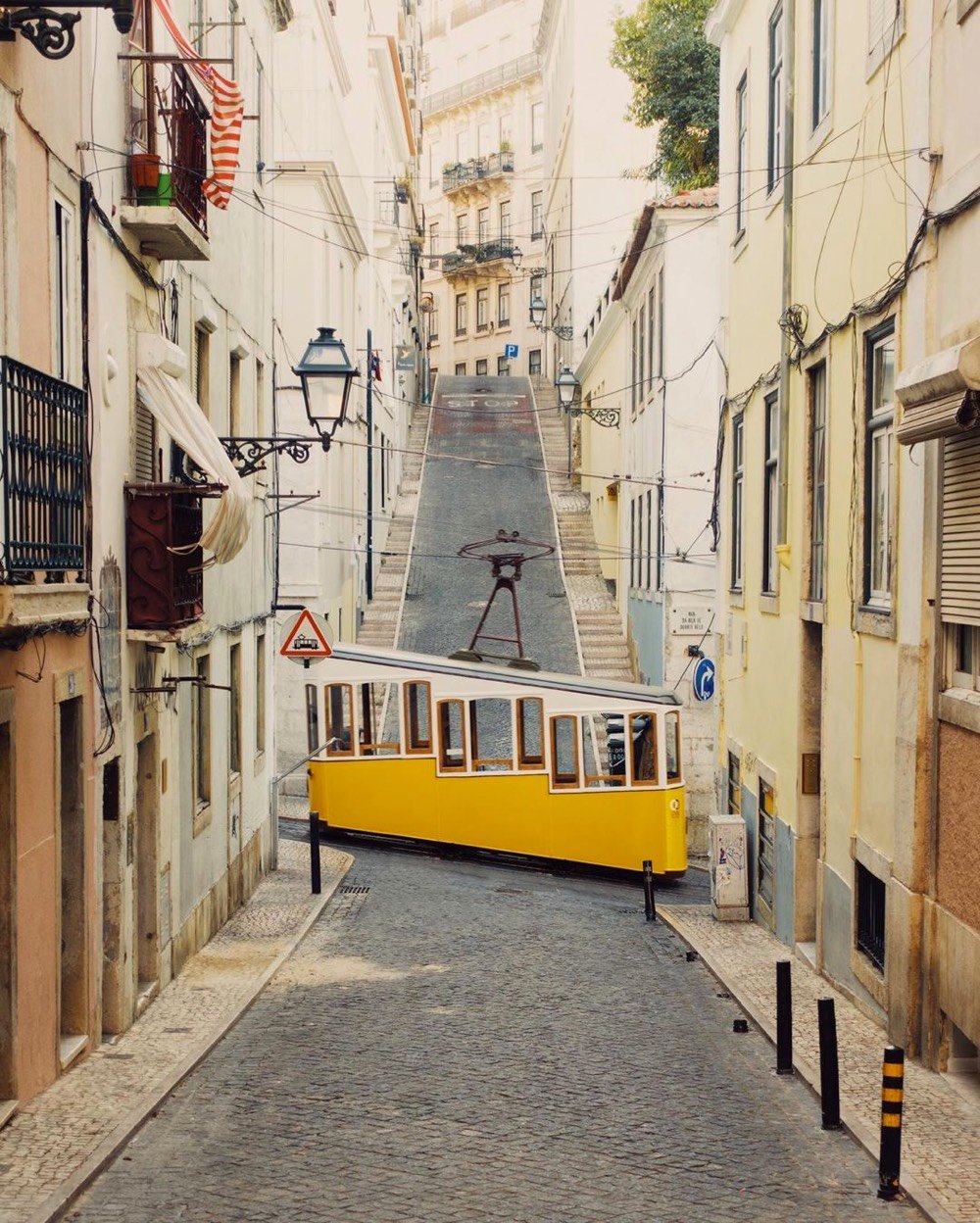

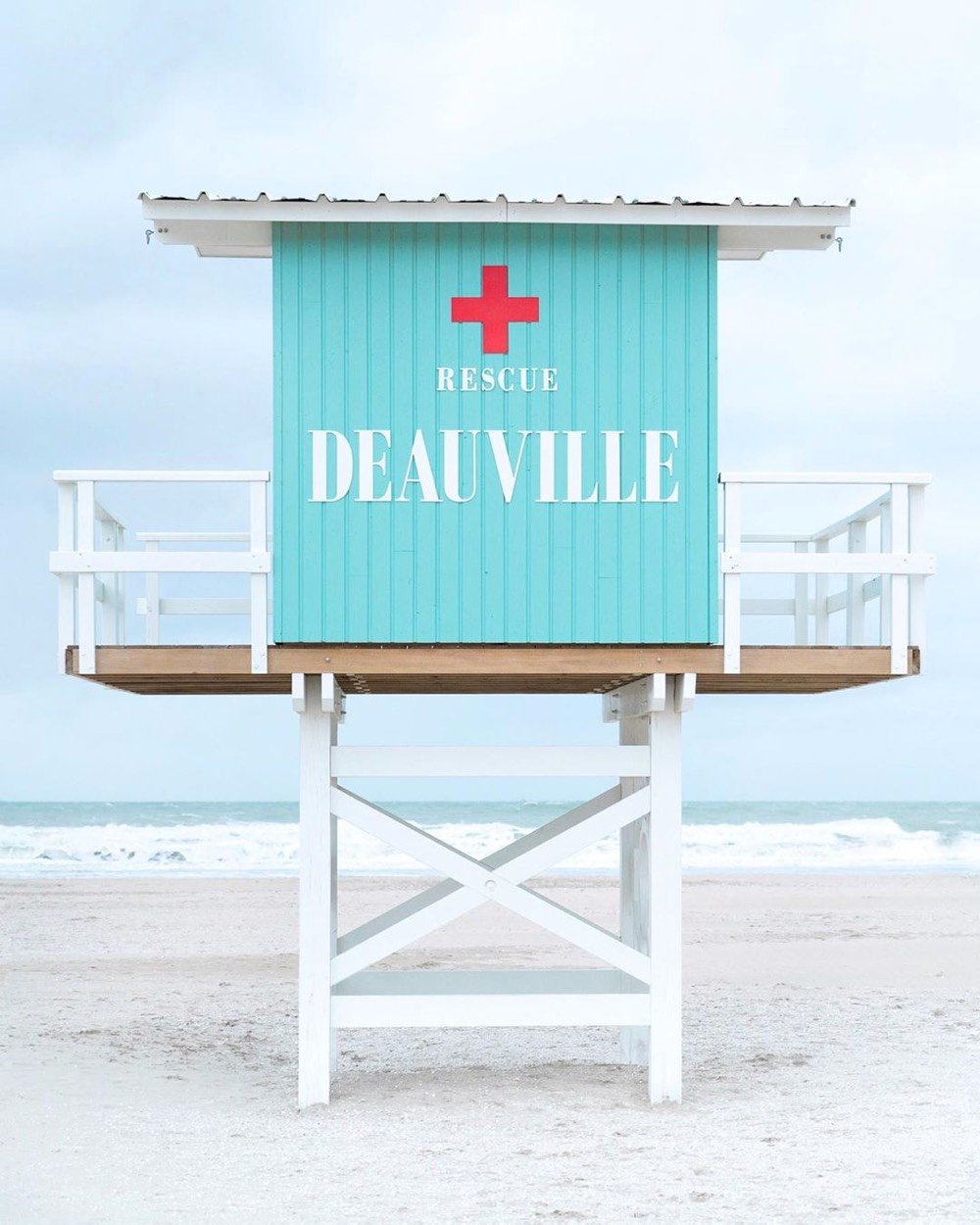
“100,000 Stars is an interactive visualization of the stellar neighborhood.” Super fun/informative and I love this playful warning: “Please do not use this visualization for interstellar navigation.”
Werner Herzog’s Entertaining Answer to “How Many Languages Do You Speak?”
This clip of an off-screen interviewer asking film director Werner Herzog how many languages he speaks and then Herzog answering is only slightly more than 90 seconds long, but it’s a masterclass in how to tell an entertaining story. He playfully misdirects at first and then just goes from there.
I do understand French but I refuse to speak it. It’s the last thing I would ever do. You can only get some French out of me with a gun pointed at my head.
The Science Is In: Wear. A. Mask!
Back in June, in a post called Jesus Christ, Just Wear a Face Mask!, I presented a bunch of evidence and arguments for wearing face masks to prevent the spread of Covid-19. Even then it was pretty clear that masks were working. In piece published by Nature yesterday, Lynne Peeples summarizes what the data and science currently says about the effectiveness of wearing face masks. Here is her one-sentence summary:
To be clear, the science supports using masks, with recent studies suggesting that they could save lives in different ways: research shows that they cut down the chances of both transmitting and catching the coronavirus, and some studies hint that masks might reduce the severity of infection if people do contract the disease.
And importantly, even ardently pro-mask scientists agree that masks should be worn in conjunction with taking other precautions: limiting large gatherings, maintaining distance, limiting the time you spend indoors with others, etc.
A recent study shows that people adhering to an intermittent fasting diet didn’t lose more weight (statistically speaking) when compared to those in a control group. “People in clinical trials [tend] to lose weight no matter what you do.”
Everyone I know is either drinking more these days or has stopped drinking. If you’re in the latter category (or would like to be), check out Good Drinks, a new book of alcohol-free cocktails recipes from Julia Bainbridge.
The Alvin and the Chipmunks Version of Koyaanisqatsi
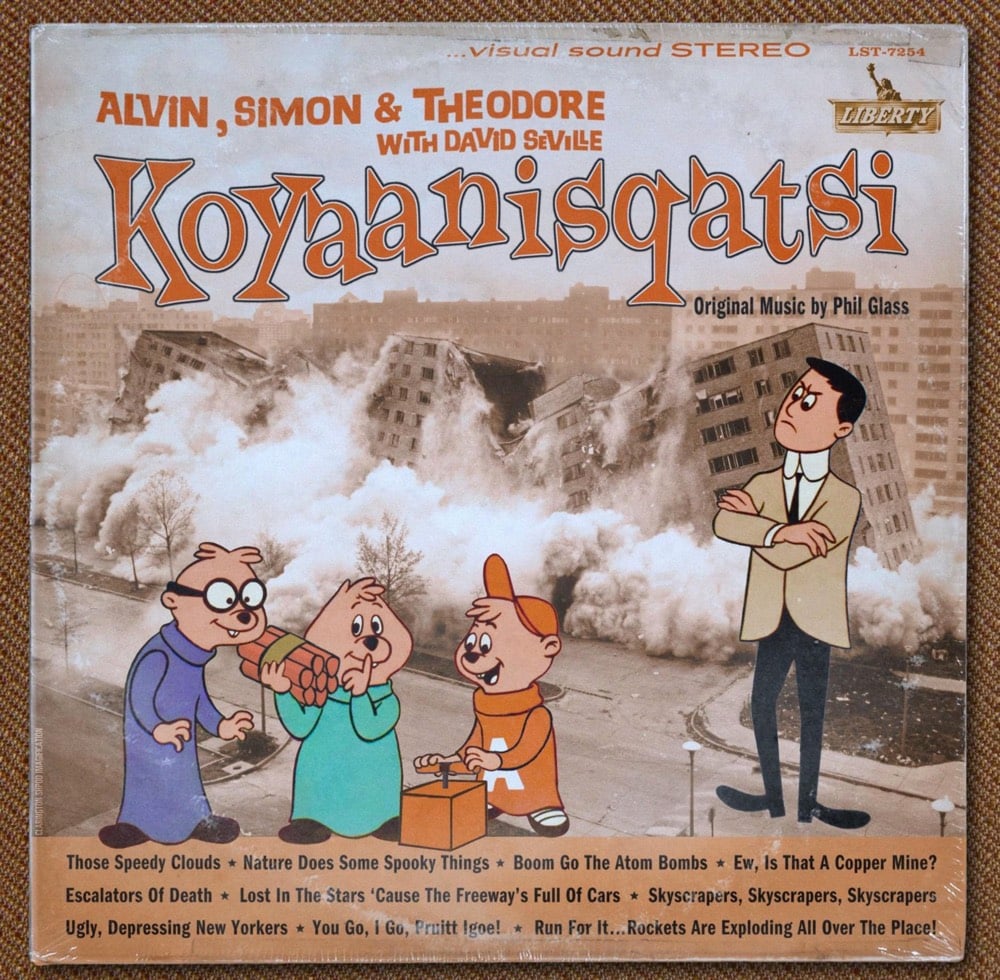
This album cover was tweeted out the other day by Philip Glass’s official account with no additional comment. What really makes it IMO is the song titles listed at the bottom of the cover: Those Speedy Clouds, Escalators of Death, Run For It…Rockets Are Exploding All Over the Place!
I tried to track down who made this, but the only other instance I could find online was on Philip Glass’s Instagram exactly one year ago. Koyaanisqatsi is a serious work of art — it’s refreshing to see how playful Glass is about its representation. You could imagine other artists/musicians not being so chill about it.
Update: Aha, designer Cris Shapan made this. (via @jdpbbank)
Update: Here’s a short snippet of what this album might sound like.
Interesting to see the CRISPR Nobel go to Charpentier & Doudna over George Church & Feng Zhang – the two groups have been jockeying for invention credit for years. But Nobels can only be shared by a max of 3 people.
The Winners of the 2020 Drone Photo Awards

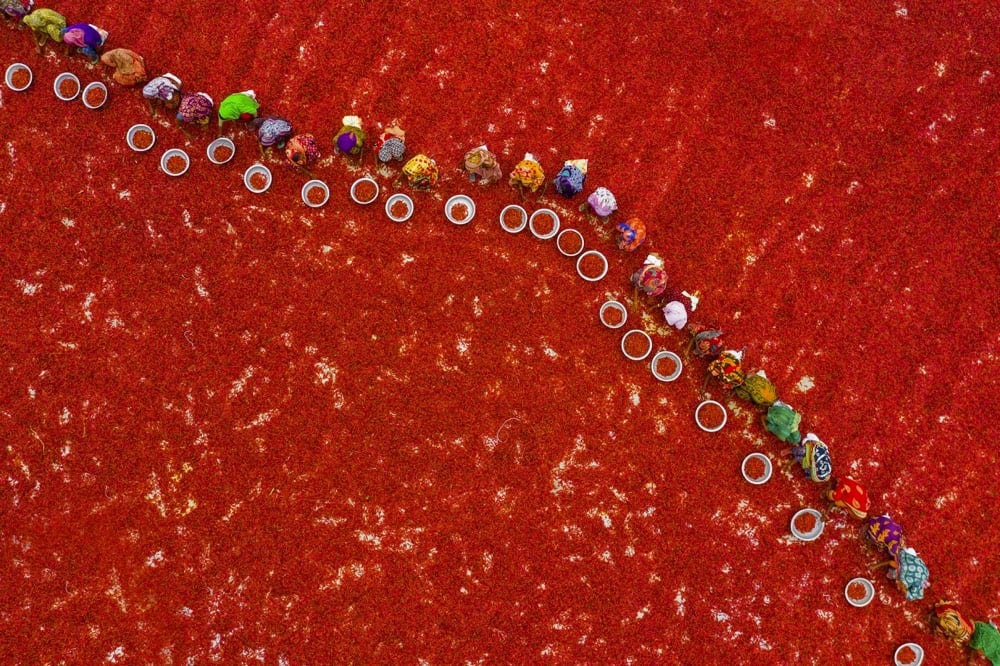

Lots of good aerial photography in the 2020 Drone Photo Awards in several categories (abstract, urban, people, nature, wildlife). Photos above by Paul Hoelen, Azim Khan Ronnie, and Paul McKenzie.
In the US, women (especially married women) are faring worse in the recession than men. “Married women lost almost 1 million jobs last month. (Single men gained 1.2 million.)”
Erno Rubik’s New Book on “the Imperfect Science of Creation”
Erno Rubik recently wrote what sounds like a delightfully unorthodox autobiography/memoir about his invention of the Rubik’s Cube and his philosophy about creativity.
In Cubed, Rubik covers more than just his journey to inventing his eponymous cube. He makes a case for always being an amateur-something he has always considered himself to be. He discusses the inevitability of problems during any act of invention. He reveals what it was like to experience the astonishing worldwide success of an object he made purely for his own play. And he offers what he thinks it means to be a true creator (hint: anyone can do it). Steeped in the wisdom and also the humility of a born inventor, Cubed offers a unique look at the imperfect science of creation.
Even the structure of the book is odd. From a review of the book in the NY Times by Alexandra Alter:
“On the way to trying to understand the nature of the cube, I changed my mind,” Rubik said. “What really interested me was not the nature of the cube, but the nature of people, the relationship between people and the cube.”
Reading “Cubed” can be a strange, disorienting experience, one that’s analogous to picking up and twisting one of his cubes. It lacks a clear narrative structure or arc — an effect that’s deliberate, Rubik said. Initially, he didn’t even want the book to have chapters or even a title.
“I had several ideas, and I thought to share this mixture of ideas that I have in my mind and leave it to the reader to find out which ones are valuable,” he said. “I am not taking your hands and walking you on this route. You can start at the end or in the middle.”
I’ve never learned how to solve one without consulting a book, but like many people who grew up in the 80s, I’ve always been captivated by the Rubik’s Cube. It’s both simple and endlessly complex and can somehow be solved in under 3.5 seconds now. It’s exactly the type of thing that could only have been invented by an amateur in his spare time and who still wonders about it almost 50 years later. (via austin kleon)
10 things you need to know to stop a coup. “5. Focus on widely shared democratic values, not on individuals.”
The trailer for Iron Mask. An action movie starring a 66-year-old Jackie Chan and a 73-year-old Arnold Schwarzenegger? Sure, why not.
Representing Covid-19 Deaths, 20,000 Empty Chairs Face the White House
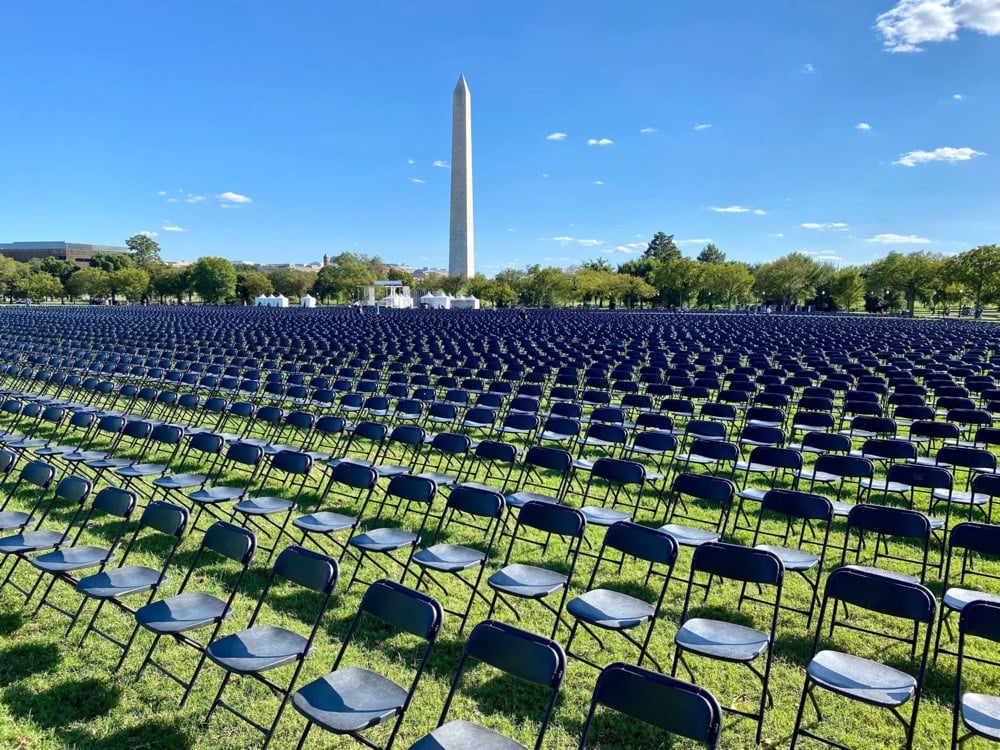
On Sunday in Washington DC, a group called Covid Survivors for Change set up 20,000 chairs in front of the White House to represent the 210,000 people who have died from Covid-19 in the United States.1 Each chair represents about 10 people who have died and their collective emptiness represents both the loss felt by the families & loved ones of those who have died and the feckless, hollow response of the federal government to the suffering.
I’m going to point out once again that whenever you see a number in the media for Covid-19 deaths, that’s the official count. But if you look at the excess mortality in the United States during the period in question, the true death toll is significantly higher. “For example, the US suffered some 260,000 more deaths than the five-year average between 1 March and 16 August, compared to 169,000 confirmed COVID-19 deaths during that period.”↩
David Attenborough: A Life on Our Planet
Now streaming on Netflix, David Attenborough: A Life on Our Planet, a documentary about the 94-year-old broadcaster, naturalist, and international treasure.
In this unique feature documentary, titled David Attenborough: A Life On Our Planet, the celebrated naturalist reflects upon both the defining moments of his lifetime and the devastating changes he has seen. Coming to Netflix October 4 2020, the film addresses some of the biggest challenges facing life on our planet, providing a snapshot of global nature loss in a single lifetime. With it comes a powerful message of hope for future generations as Attenborough reveals the solutions to help save our planet from disaster.
In the trailer (embedded above), Attenborough says “I had the most extraordinary life. It’s only now that I appreciate how extraordinary.” In saying that, he’s speaking not only as a living legend whose long career in television and science has brought him nearly universal acclaim, but also as someone who can look back and see how recognizably and thoroughly the Earth has changed during his lifetime. The depletion of animal populations, the changing climate, the shifting habitats — he’s witnessed firsthand how much humans have fucked up the planet. We should listen to his testimony and suggestions for fixing what he calls “our greatest mistake”. I hope it’s not too late.
Xi’an Famous Foods Cookbook!
I moved away from NYC more than four years ago, and I still think about Xi’an Famous Foods all the time. I miss going there and pondering the make-up of the mind-bendingly delicious sauces they ladled out onto their hand-pulled noodles — “What the hell is in here that makes it taste so good?” Xi’an is one of my favorite restaurants, but with the pandemic and all, the last time I ate there was nearly an entire year ago. So it’s not an understatement to say that I’m overjoyed to see that they are coming out with a cookbook: Xi’an Famous Foods: The Cuisine of Western China, from New York’s Favorite Noodle Shop .
CEO Jason Wang divulges the untold story of how this empire came to be, alongside the never-before-published recipes that helped create this New York City icon. From heavenly ribbons of liang pi doused in a bright vinegar sauce to flatbread filled with caramelized pork to cumin lamb over hand-pulled Biang Biang noodles, this cookbook helps home cooks make the dishes that fans of Xi’an Famous Foods line up for while also exploring the vibrant cuisine and culture of Xi’an.
Lemme just highlight the most important part of that paragraph: never-before-published recipes. YESSSSS. The cookbook is coming out next week, but you can pre-order it now from Bookshop.org and Amazon.
The Case for Dumping the Electoral College. “It effectively dilutes the votes of African-Americans, Latinos, and Asian-Americans, because they live disproportionately in populous states.”
Ella Fitzgerald, The Lost Berlin Tapes
In 1962, Ella Fitzgerald performed a show in Berlin, just two years after the famous performance that earned the jazz great two Grammys for masterfully butchering the lyrics to Mack the Knife. The recording for the ‘62 Berlin show was presumed lost until it was recently rediscovered in the archive of a record executive.
Early this year, Mr. Field and Ken Druker, a vice president at Verve — which survives today under the auspices of Universal Music Group — were digging through a rediscovered trove of live recordings that Granz had stashed away decades ago. They came across an apparently untouched reel-to-reel, with yellowed Scotch tape still holding the box shut, featuring a concert Fitzgerald had given in Berlin two years after that first famous outing.
Upon inspection, they found that recordings had been made in both mono and stereo — a rare stroke of luck. They listened, and the quality was excellent. Using a new engineering software that allowed him to more precisely isolate the instruments and Fitzgerald’s voice, Mr. Field filled out the low end and brought her singing to the front.
The result of their discovery is The Lost Berlin Tapes, now available in stores and various streaming plaforms. Here’s Fitzgerald singing Mack the Knife from that performance:
And the whole album on Spotify:
(via @tedgioia)
Like Humans, Crows Can “Ponder the Content of Their Own Minds”
A recent study that looked at the brain patterns of crows when performing tasks found evidence that they “know what they know and can ponder the content of their own minds”, an attribute that was previously thought to exist only in humans and some monkeys.
The birds were aware of what they subjectively perceived, flash or no flash, correctly reporting what their sensory neurons recorded, Nieder told STAT. “I think it demonstrates convincingly that crows and probably other advanced birds have sensory awareness, in the sense that they have specific subjective experiences that they can communicate,” he said. “Besides crows, this kind of neurobiological evidence for sensory consciousness only exists in humans and macaque monkeys.”
(via kottke ride home)
Reddit’s “Am I the Asshole?” forum reveals the casual sexism of the American male. “Sexism has fully lulled them into a sense of moral superiority that blinds them to their own explicitly terrible behavior.”
One of President John Tyler’s Two Living Grandsons Just Died
Last weekend, Lyon Gardiner Tyler Jr. died at the age of 95. Remarkably, Lyon was the grandson of John Tyler, the 10th President of the United States. His brother Harrison Ruffin Tyler is still alive. Here’s what I wrote about the Tylers back in 2012:
John Tyler was the 10th President of the United States. He was born in 1790 and took office in 1841. His son, Lyon Gardiner Tyler, was born in 1853, when Tyler was 63 years old. In turn, Lyon had six children with two different wives, two of whom were Lyon Gardiner Tyler, Jr. and Harrison Ruffin Tyler (born 1924 & 1928 respectively, when Lyon Sr. was in his 70s).
John Tyler was born barely a year into George Washington’s first term and undoubtably met and even worked with some of the nation’s earliest political figures, including Thomas Jefferson and John Quincy Adams. Amazing to think that just three generations of the same family stretch almost all the way back to the founding of our country. It underscores just how young the United States is — after all, the last person to receive a Civil War pension just died back in June. You can check out more examples of The Great Span phenomenon here.
Totally Under Control
In secrecy over the past several months, filmmaker Alex Gibney has been making a documentary film about the US government’s response to the Covid-19 pandemic called Totally Under Control. He and co-directors Ophelia Harutyunyan and Suzanne Hillinger interviewed “countless scientists, medical professionals, and government officials on the inside” to produce the film.
Academy Award-winning filmmaker Alex Gibney, directing with Ophelia Harutyunyan and Suzanne Hillinger, interrogates this question and its devastating implications in Totally Under Control. With damning testimony from public health officials and hard investigative reporting, Gibney exposes a system-wide collapse caused by a profound dereliction of Presidential leadership.
Gibney previously directed Enron: The Smartest Guys in the Room, Going Clear, and Zero Days (all excellent documentaries). The film comes out in theaters on October 13 and on Hulu on October 20.
How to Protect Yourself from the Aerosol Spread of Covid-19
A group of scientists who believe that WHO and the CDC are being too slow in acknowledging the role of aerosol transmission in spreading Covid-19 have written up a Google Doc of advice for the public: FAQs on Protecting Yourself from COVID-19 Aerosol Transmission.
The goal of these FAQs is to provide information to the general public in an efficient manner about how to prevent aerosol transmission of COVID-19, with the hope that this will allow more informed decision making by individuals or organizations. All of this information has been posted in Twitter and other forums, but can be difficult to find. Having multiple experts working together, and having the ability to update this information also improves its quality. These FAQs represent our best understanding at this time, and should always be similar or more stringent than information provided by CDC, WHO, and most regional & local health authorities. If your authority has a more stringent guideline than discussed here, follow that more stringent guideline.
The group was organized by chemist Jose-Luis Jimenez, who has been studying aerosols for 20 years. You may remember Jimenez from his excellent piece in Time magazine, where he used the analogy of smoke to explain aerosol transmission. Here’s a snippet from the FAQ, highlighting something I’ve been concerned about lately: people wearing face shields instead of masks and employees in stores not wearing masks behind plexiglass shields:
7.13. Are face shields and masks interchangeable?
No, face shields do not offer much protection against aerosols (also see this video), while masks do. Face shields are good for blocking ballistic droplets released by the wearer or that might fly into the wearer’s face when close to others. Face shields are considered a supplement to masks for partial eye protection (but less useful than closed glasses, as discussed above), but not a substitute for them.
7.14. Are plexiglass barriers helpful?
Plexiglass barriers are generally useful to avoid direct droplet infection and direct aerosol transmission whenever people are in close proximity and distance cannot be kept. Therefore, it is recommended to use them as a direct transmission suppression tool at such places, such as a supermarket checkout.However, as aerosols follow the air movements indoors, the protective effects of the plexiglas barriers against aerosols will be limited. Plexiglas barriers alone are not a sufficient approach to protect against aerosol transmission. Their installation alone cannot protect against indoor aerosol transmission and should not be regarded as safe and sufficient protection.
MIT Technology Review’s Charlotte Jee interviewed Jimenez about the FAQ document.
We update the document all the time. We’re effectively having to be a little WHO or CDC. We’re saying the things that they should be saying. This is frustrating, but it’s the situation we find ourselves in. These organizations have been flat-out refusing to consider if aerosol transmission is important, which leaves people unprotected. So we feel it’s our duty to communicate directly with the public.
Right now, in my opinion as someone who has done a ton of reading about Covid-19, the most best accessible information on how individuals and societies can protect themselves and others during the pandemic (and why) is available in Jimenez’s Time article, Aaron Carroll’s NY Times piece about how to think about risk management, Zeynep Tufekci’s piece in the Atlantic about dispersion and superspreading, and now this Google Doc by Jimenez et al.
It’s looking like Saturday’s White House event introducing Amy Coney Barrett as the SCOTUS nominee was a superspreader event. At least 5 people who were there have tested positive for Covid-19. (scroll up in thread…)
Trailer for The Witches, an adaptation of the Roald Dahl book directed by Robert Zemeckis and starring Octavia Spencer, Anne Hathaway, Stanley Tucci, and Chris Rock. Premiering on HBO Max on Oct 22.
The Songs of 1990-1999
After creating a series of music video mixes for the entire decade of the 80s (and 1979), the Hood Internet is back to take us through the 90s. Their first video, on 1990, features 60 different songs in only 3.5 minutes and is embedded above.
1990 was my last year of high school, so this is a total memory bomb for me. I listened to a lot of C & C Music Factory, Divinyls, DJ Jazzy Jeff & The Fresh Prince, En Vogue, Madonna, Mariah Carey, MC Hammer, Roxette, Salt-n-Pepa, Sinéad O’Connor, Whitney Houston, and missed whole scores of much cooler music that was unavailable to me because I lived in the middle of nowhere where the listening choices were country, heavy metal, or top 40. It’s an understatement to say that college was very musically eye-opening for me.
Update: Here are the installments from 1991, 1992, and 1993. Right into my college years and so hugely nostalgic.
Update: Here’s their 34-minute megamix of 600 songs from 1990-1999.
This playlist on Soundcloud has each year’s mix from 1975-1999 and there are also yearly playlists of all the songs used for these mixes on Spotify (scroll down to “Artist Playlists”).
“This Overlooked Variable Is the Key to the Pandemic”
Zeynep Tufekci says that we are paying too much attention to the R value of SARS-CoV-2 (basically the measure of its contagiousness) and not nearly enough attention to the k value (“whether a virus spreads in a steady manner or in big bursts, whereby one person infects many, all at once”).
There are COVID-19 incidents in which a single person likely infected 80 percent or more of the people in the room in just a few hours. But, at other times, COVID-19 can be surprisingly much less contagious. Overdispersion and super-spreading of this virus is found in research across the globe. A growing number of studies estimate that a majority of infected people may not infect a single other person. A recent paper found that in Hong Kong, which had extensive testing and contact tracing, about 19 percent of cases were responsible for 80 percent of transmission, while 69 percent of cases did not infect another person. This finding is not rare: Multiple studies from the beginning have suggested that as few as 10 to 20 percent of infected people may be responsible for as much as 80 to 90 percent of transmission, and that many people barely transmit it.
We’ve known, or at least suspected, this about SARS-CoV-2 for awhile now — I linked to two articles about superspreading back in May and June — but Tufekci says we have not adjusted our thinking about what that means for prevention. We should be avoiding superspreading environments/events (“Avoid Crowding, Indoors, low Ventilation, Close proximity, long Duration, Unmasked, Talking/singing/Yelling”), doing backwards contact tracing, and rapid testing.
In an overdispersed regime, identifying transmission events (someone infected someone else) is more important than identifying infected individuals. Consider an infected person and their 20 forward contacts-people they met since they got infected. Let’s say we test 10 of them with a cheap, rapid test and get our results back in an hour or two. This isn’t a great way to determine exactly who is sick out of that 10, because our test will miss some positives, but that’s fine for our purposes. If everyone is negative, we can act as if nobody is infected, because the test is pretty good at finding negatives. However, the moment we find a few transmissions, we know we may have a super-spreader event, and we can tell all 20 people to assume they are positive and to self-isolate-if there is one or two transmissions, it’s likely there’s more exactly because of the clustering behavior. Depending on age and other factors, we can test those people individually using PCR tests, which can pinpoint who is infected, or ask them all to wait it out.
Part of the problem is that dispersion and its effects aren’t all that intuitive.
Overdispersion makes it harder for us to absorb lessons from the world because it interferes with how we ordinarily think about cause and effect. For example, it means that events that result in spreading and non-spreading of the virus are asymmetric in their ability to inform us. Take the highly publicized case in Springfield, Missouri, in which two infected hairstylists, both of whom wore masks, continued to work with clients while symptomatic. It turns out that no apparent infections were found among the 139 exposed clients (67 were directly tested; the rest did not report getting sick). While there is a lot of evidence that masks are crucial in dampening transmission, that event alone wouldn’t tell us if masks work. In contrast, studying transmission, the rarer event, can be quite informative. Had those two hairstylists transmitted the virus to large numbers of people despite everyone wearing masks, it would be important evidence that, perhaps, masks aren’t useful in preventing super-spreading.
The piece is an important read and interesting throughout: just read the whole thing.
Irish court: Subway’s bread isn’t bread. It’s too sugary and therefore it “should thus be classified as confectionery”.





Stay Connected